appliqué |əˈpliːkeɪ|
noun
- decorative work in which one piece of cloth is sewn or fixed onto another
What do you think when you hear the word ‘appliqué’?
The dictionary definition doesn’t quite do it for me. I guess, in the most basic terms, it’s accurate. But appliqué is so much more than ‘decorative’.
Its origins, as with many traditional crafts that have taken on a more varied life in modern culture, are functional.
Since man discovered how to sew with a needle and thread, applied fabrics have been used to repair and rejuvenate clothing. Do you have a childhood memory of patches sewn into the knees of your favourite pair of jeans? I do. My patches were paisley I think (I was a very fashion conscious 5 year old!).
Functional, decorative and so much more
And this combination of function and decoration has become synonymous with appliqué.
In Europe, from the 15th century it began to replace crewelwork on curtains and linens. It served as a way of extending the life of the item and as an imitation of the more laborious raised embroidery.
And the use of appliqué to make traditional domestic quilts evolved to incorporate story telling and the documenting of historical events in America during the 1800s.
How top textile artists incorporate appliqué
And the inventiveness with which contemporary textile artists are using this technique has also earned appliqué its rightful place as a legitimate means of artistic expression.
Modern-day practitioners use appliqué to make a statement. As a conceptual vehicle. To make bold choices with pattern and texture. To build depth through layering. And to enhance imagery, both symbolic and literal.
And yet the basis of the technique is as simple as ever.
In this article, a selection of brilliant artists tell us why appliqué has become an integral part of their visual vocabulary.
What will strike you is the technique’s versatility in application; each of the artists featured has their own unique take on appliqué. And the results are diverse and breathtaking.
Willemien de Villiers

“Appliqué was used here to frame the work, to create depth, and to add a visual reference to the sea”.
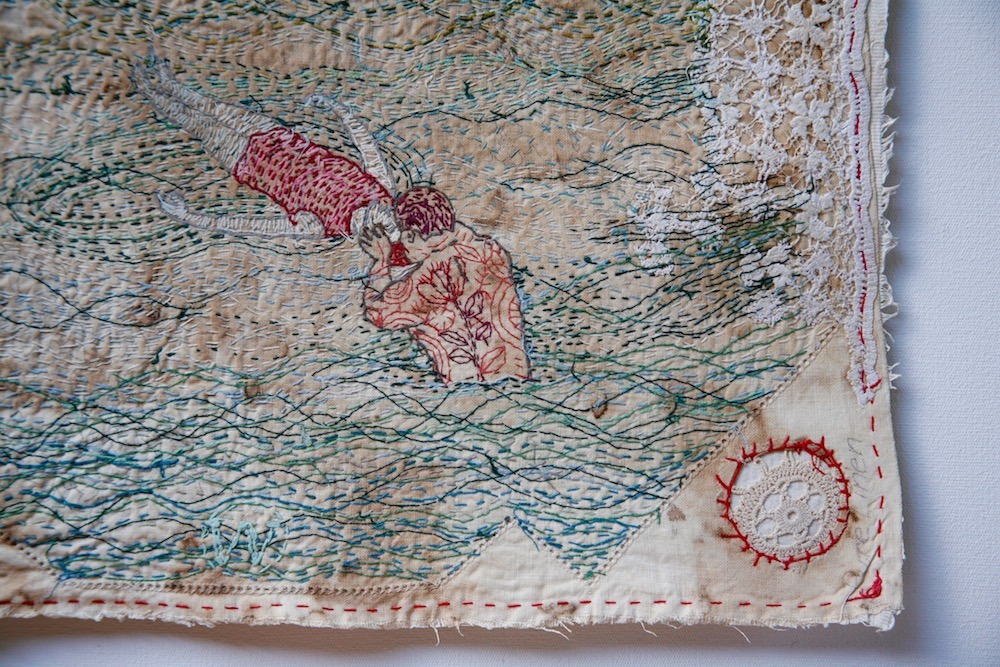
“I like creating small peepholes for the viewer to examine”.
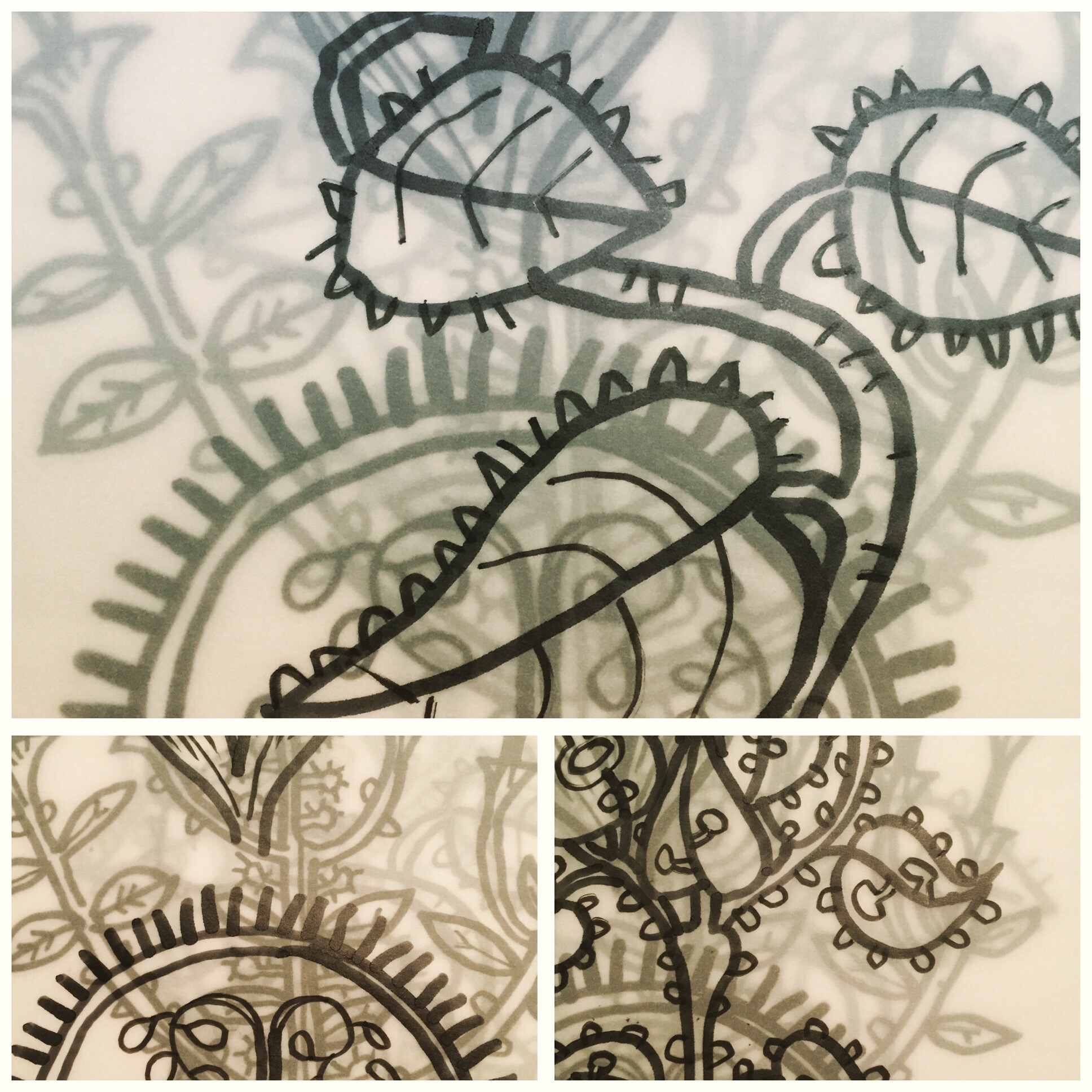
Visual texture and depth
Willemien de Villiers: Layering is important in my work, and for that reason I sometimes use appliqué.
This method not only adds visual texture and depth, but also saves time when working on a large piece. It gives me a way to create separate foundation areas a lot quicker than embellishing them by hand.
Old, worn lace is especially appealing to me; so reminiscent of cellular structures or written code for a lost language.
I sometimes knit loose structures to appliqué, using sewing thread and thick needles; when applied, the bottom image is obscured, but still visible.
I look for an emotional quality in the scraps I use that will match the mood of the work.
In Save Me, I used cotton lace, suggesting a yearning vulnerability. Its patterning also made me think of sea foam and delicate kelp lace. I like the way it frames the intimate and tender stitched area, focusing the viewer’s attention.
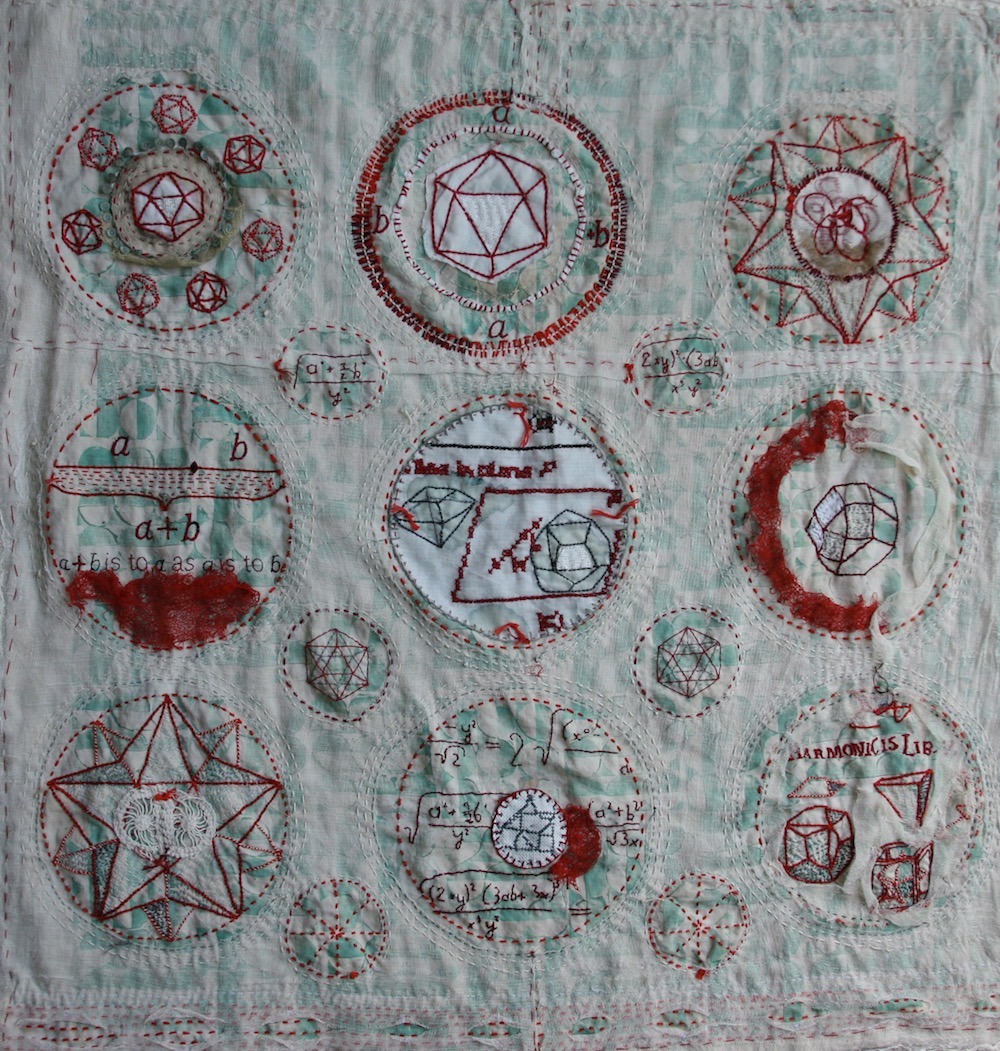
“I started this work by applying a layer of bookbinder’s cloth over the base cloth, leaving the nine circular motifs open”.
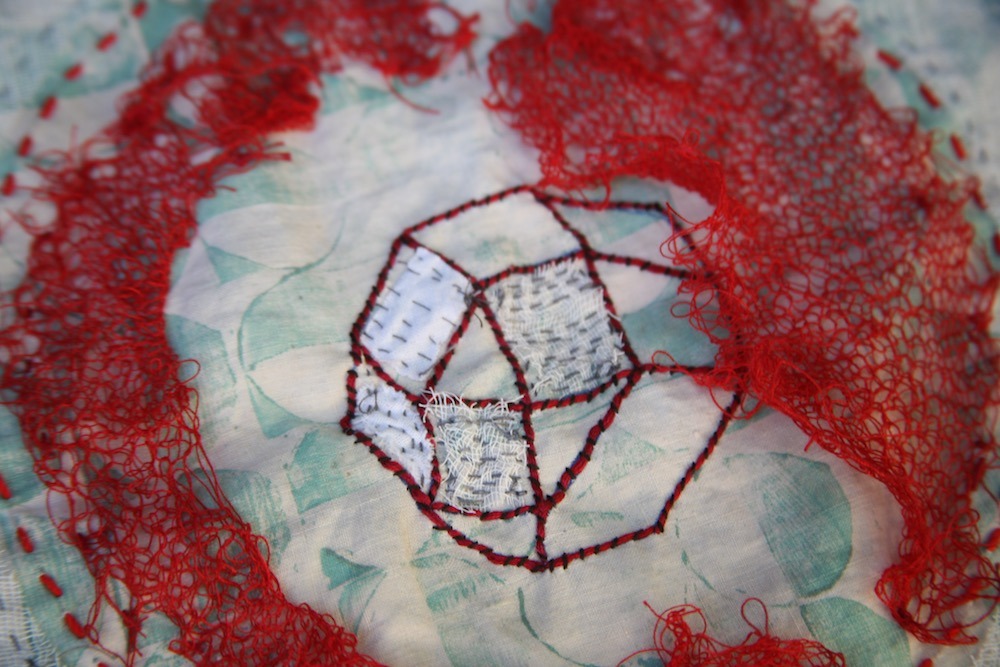
“Appliqué detail of knitted thread, cotton and bookbinder’s cloth. I prefer a loose, unstructured use of this technique”.
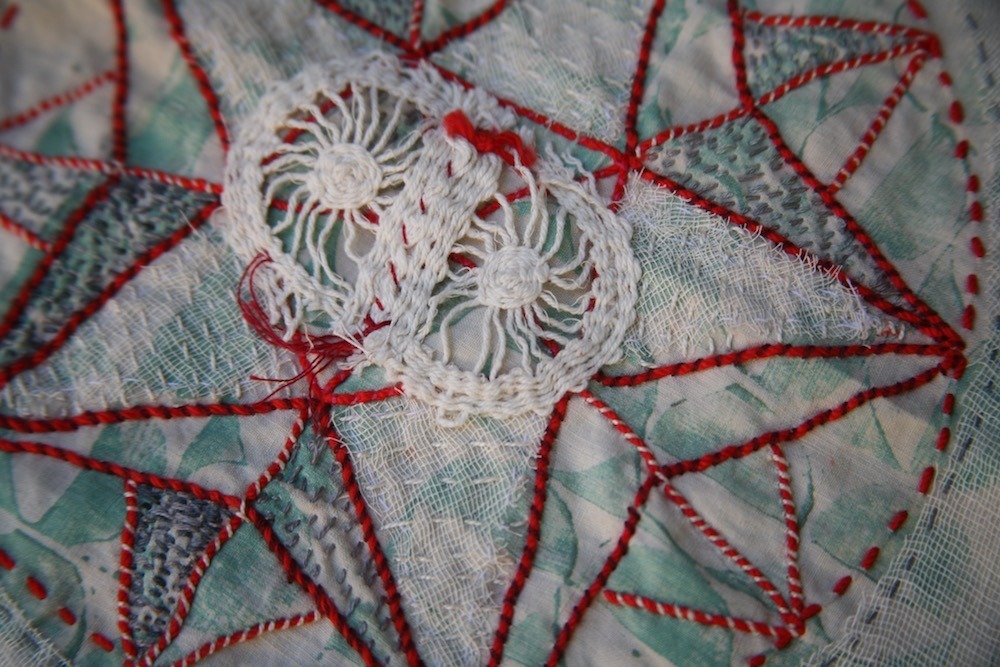
“Detail, showing bookbinder’s cloth, and a piece of cotton lace”.
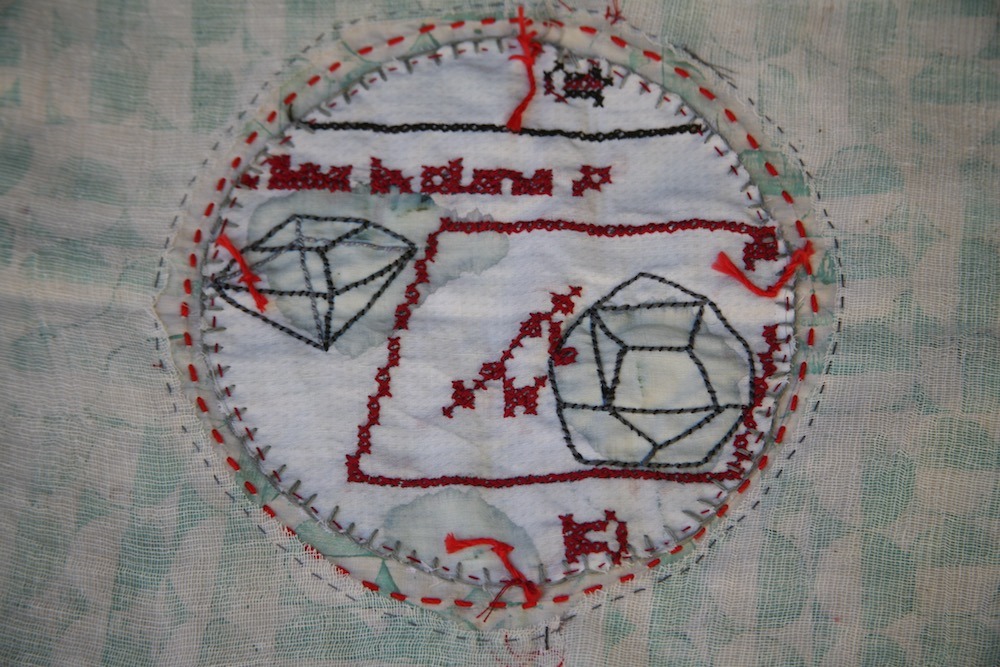
“Printed and stained circular appliqué, loosely stitched”.
Bringing together fragments
The Mysteries came about during a time when I felt overwhelmed by everything in the world.
Mathematical formulae, physics, quantum theory, etc. I so desperately wanted to understand, and was – still am – drawn to these fields. My mind feels very fragmented when I think about it though, and that is why I chose nine separate (yet loosely connected) ‘islands’ to work on.
Again, appliqué was the ideal technique to create depth and texture. And on this large piece (1.2 x 1.2m), also timesaving.
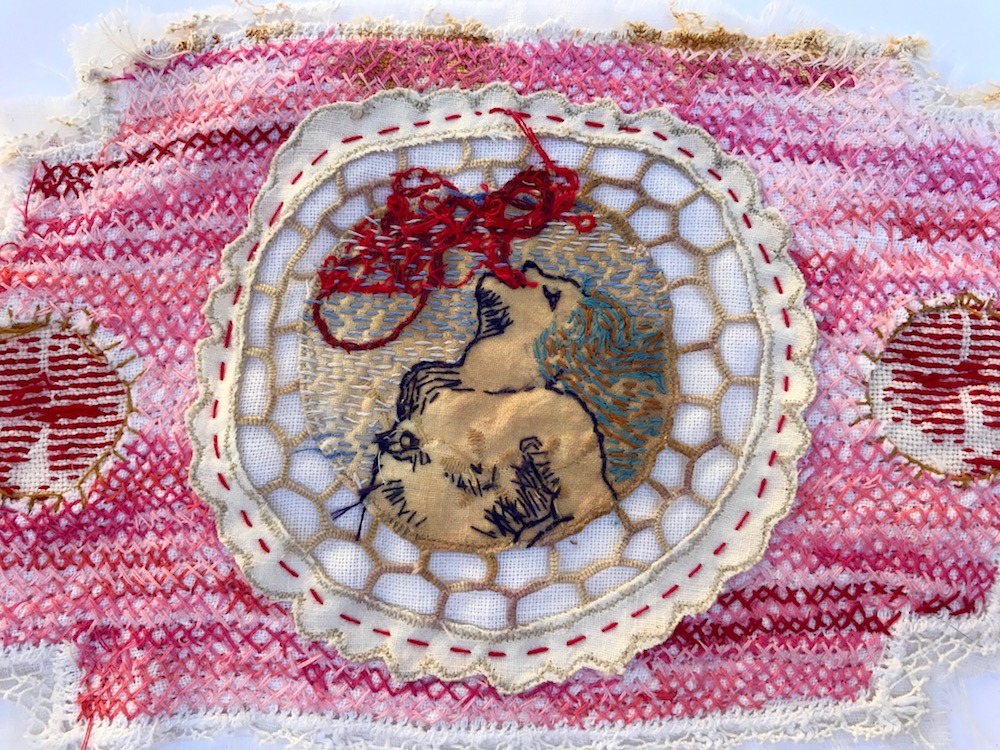
“The red-stitched circles on the sides are tucked under the top layer and blanket stitched in place. The centrepiece doily is attached with simple running stitch”.
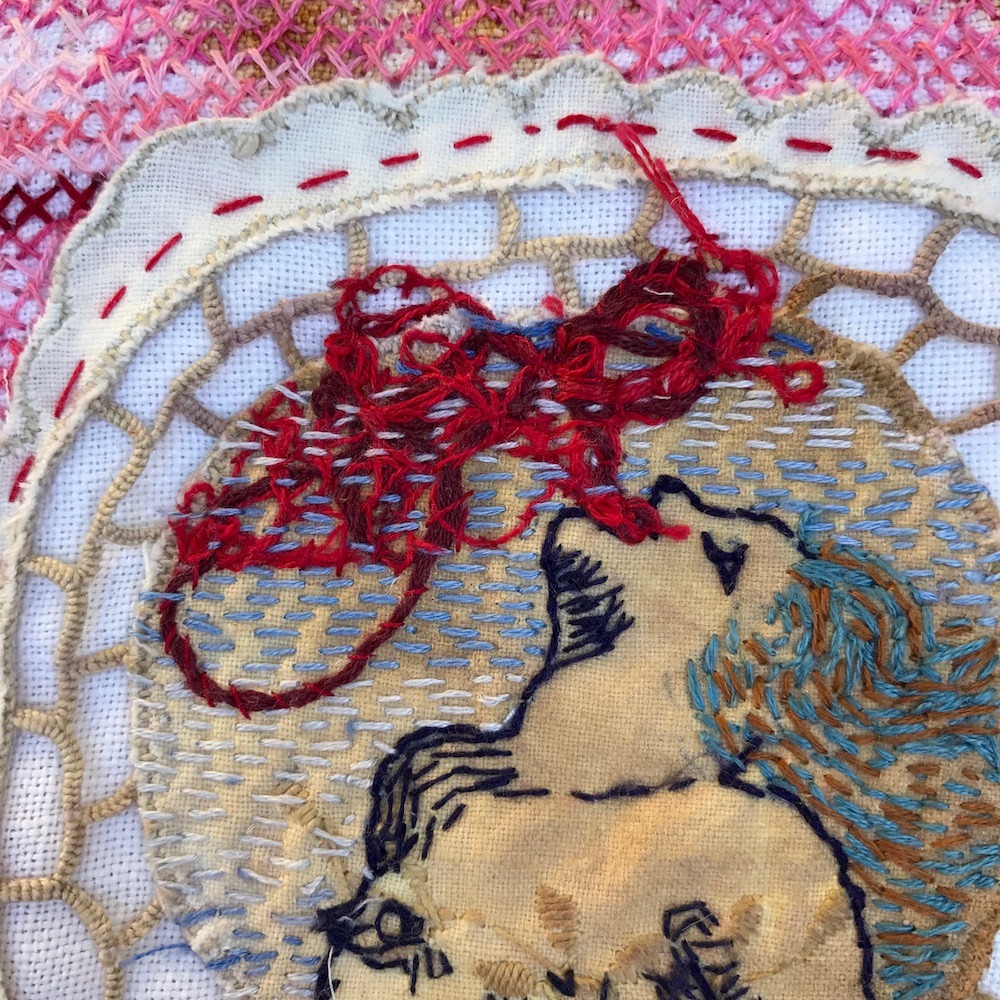
“Close-up of tangled embroidery thread, appliquéd to the surface”.
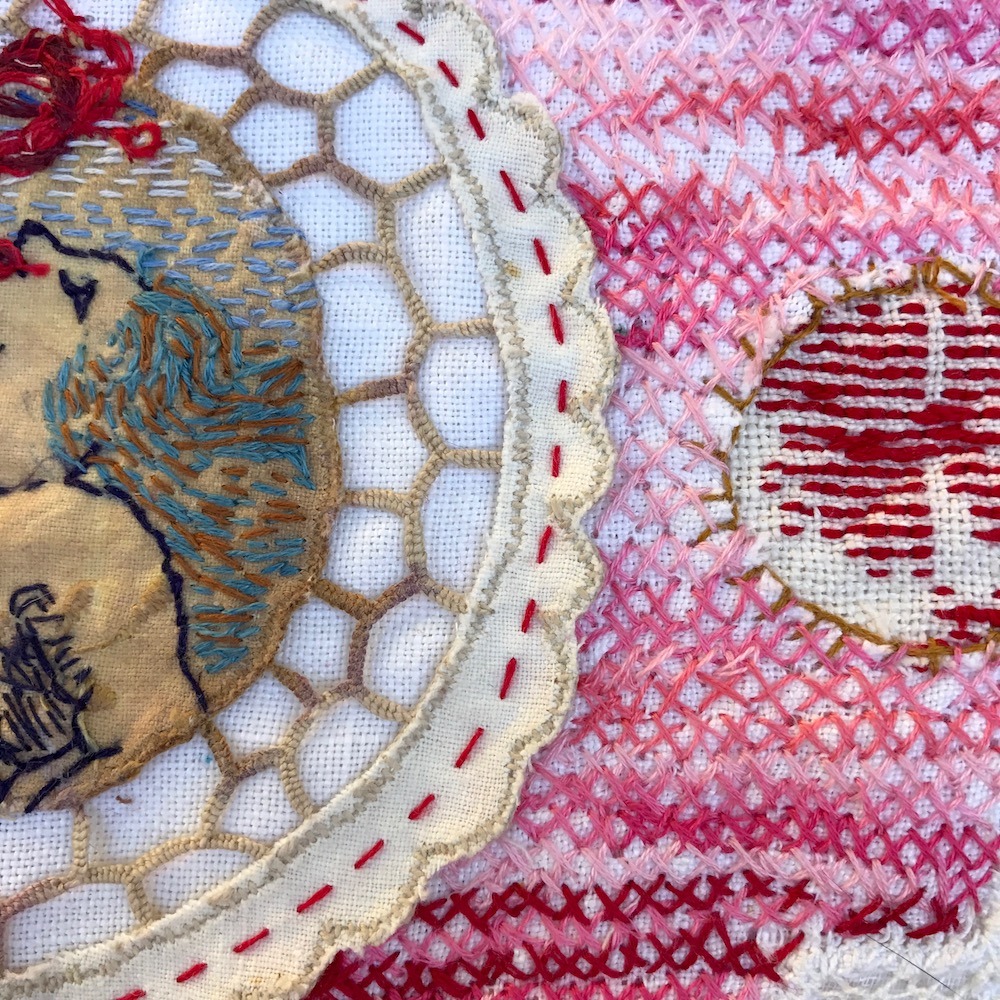
“Close-up of red-stitched peephole”.
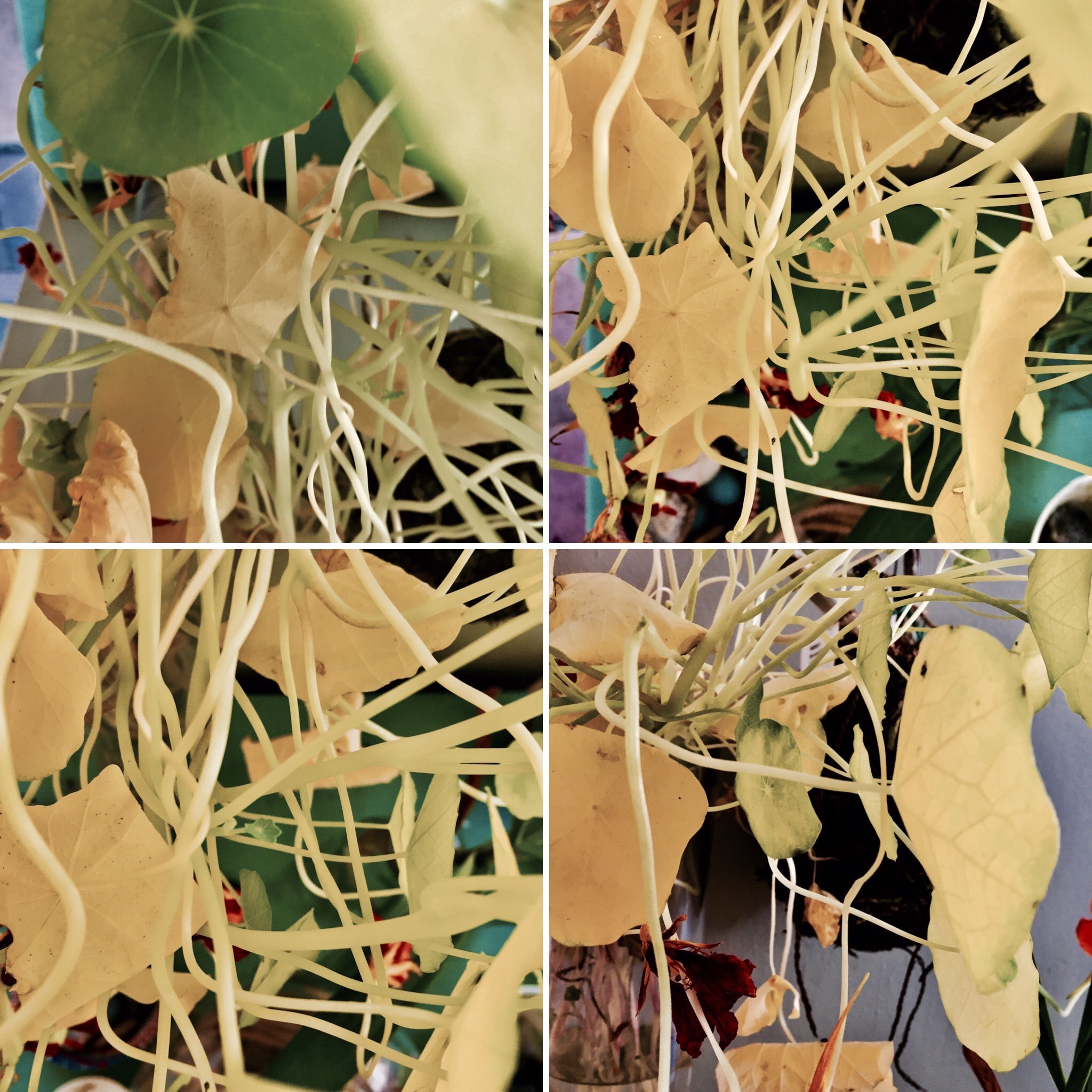
Juxtaposition of materials and themes
It Has To Be Said is a small work, expressing big anger at the current state of the world.
The small doily I chose to appliqué onto my base cloth has been on my worktable for a long time. Looking at it, turning it around, scrunching it up, smoothing it out, has become a bit of a calming ritual over the few weeks preceding my using it for this piece.
It felt good to root the message this way: a calm counterpoint for the loud stitching and arching body. The cellular-like edging adds another dimension; the interconnectedness of all living things.
Website: willemiendevilliers.co.za
Read TextileArtist.org’s interview with Willemien here
Rachael Howard
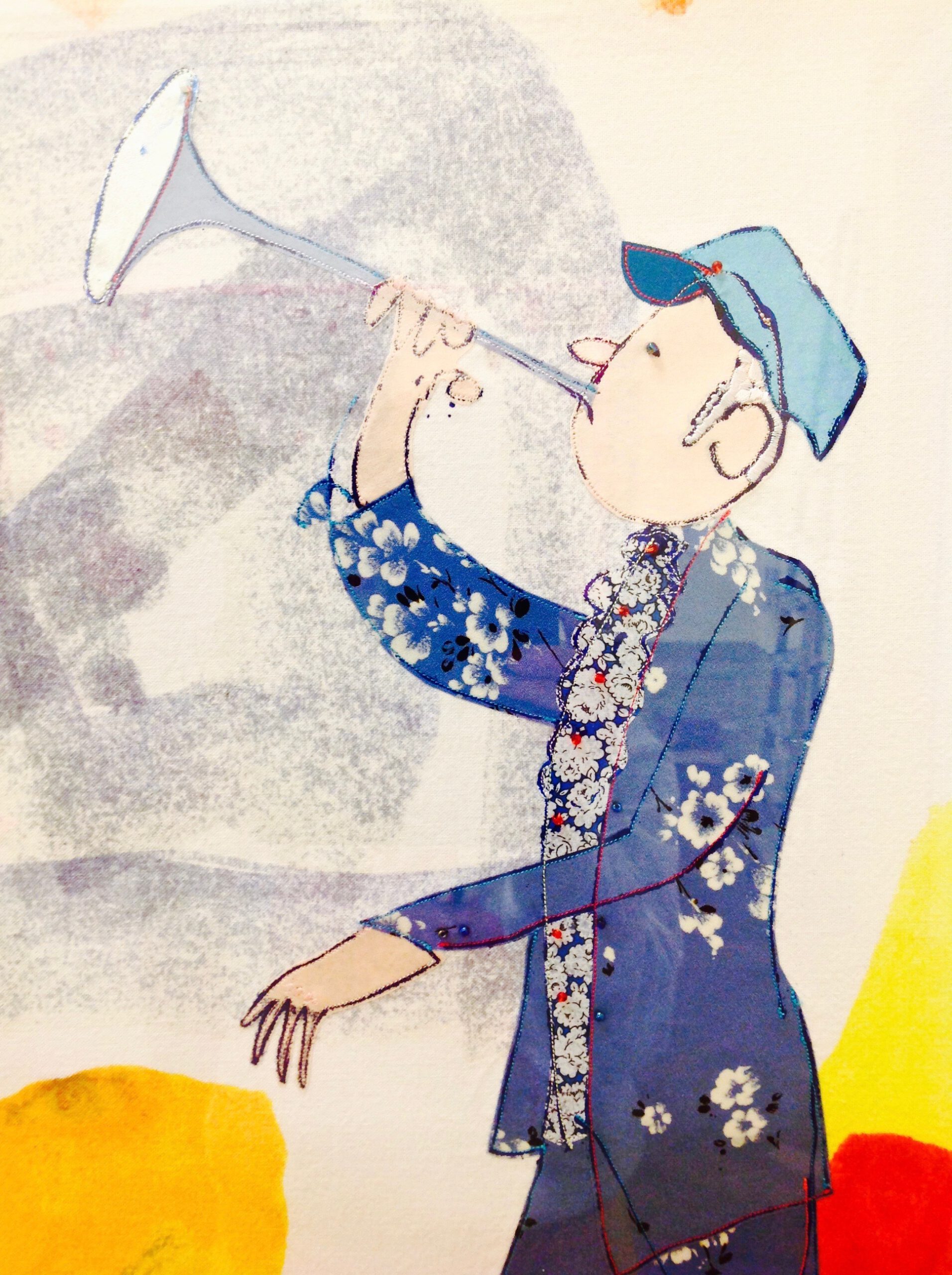
Digital and screen print, appliqué and machine stitch
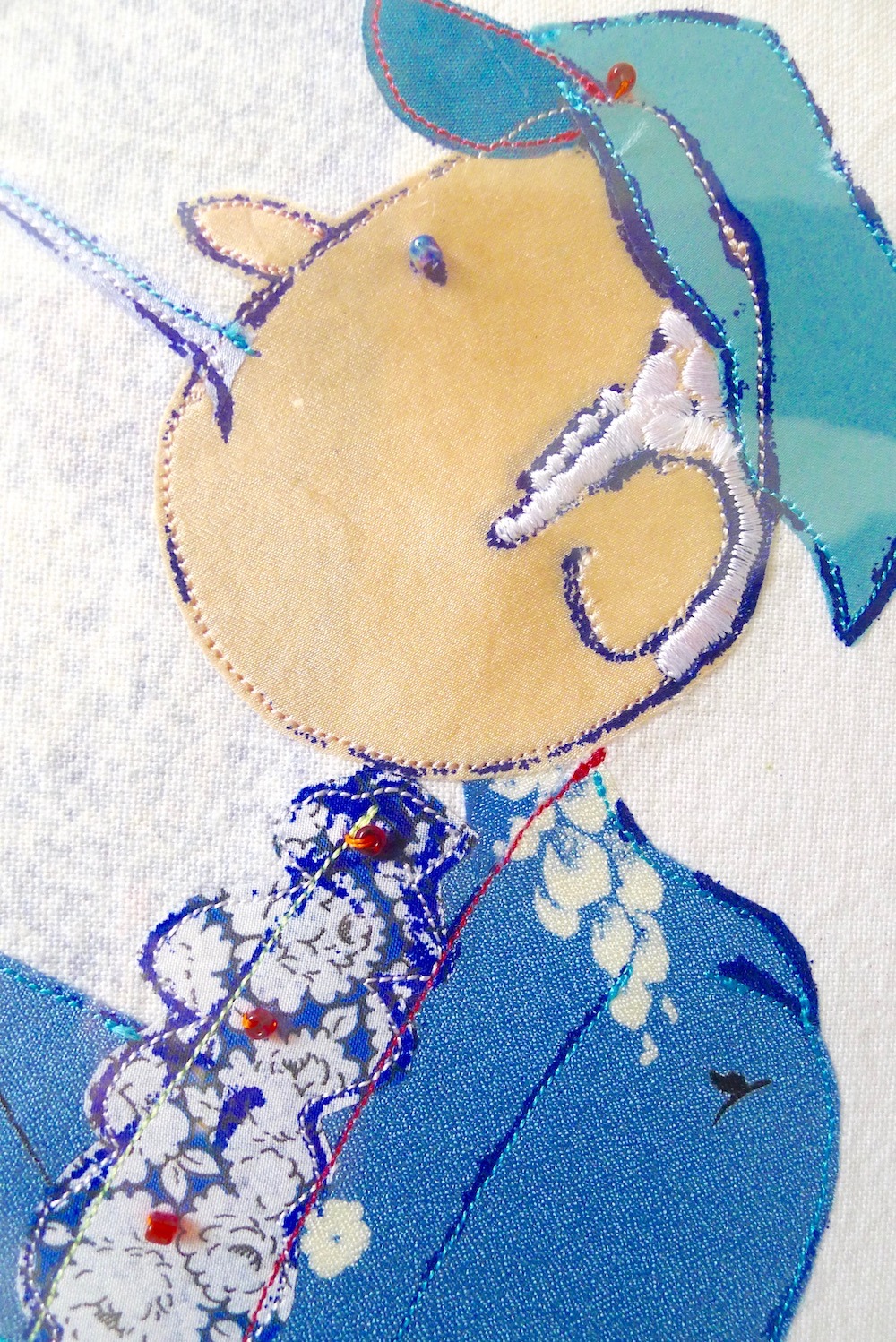
104x73cm
Digital and screen print, appliqué and machine stitch
Excited by appliqué
Rachael Howard: Appliqué is a wonderful way of colouring in my screen printed or digitally printed sketches.
My goal is to portray the essence and vitality of a figure in my sketching, the drawn, gestural line depicting a character. Adding the textile elements, including hand and machine stitch, completes the image and appliqué is an essential component of the expressive outcome.
I source fabrics from jumble sales, charity shops, fabric shops and hand me downs. Having a large collection of ready-made coloured, textured and patterned fabrics, include clothing that has worn out, affords me great spontaneity; I can pick just the right material for the sensation I’m seeking in the moment of making.
Generally, the fabrics I choose are quite flat and tightly woven as they cut well into small shapes; I often isolate a particular area of print which relates to my theme.
Using [easyazon_link identifier=”B002PHZK5G” locale=”UK” tag=”wwwtextileart-21″]bondaweb is a great way of adhering the fabric to a base; it prevents unwanted fraying and aids clean precise cutting.
Thread choice is also important; I like to use bright [easyazon_link identifier=”B01CANY2ZI” locale=”UK” tag=”wwwtextileart-21″]machine embroidery threads or [easyazon_link identifier=”B001689HYK” locale=”UK” tag=”wwwtextileart-21″]variegated threads .
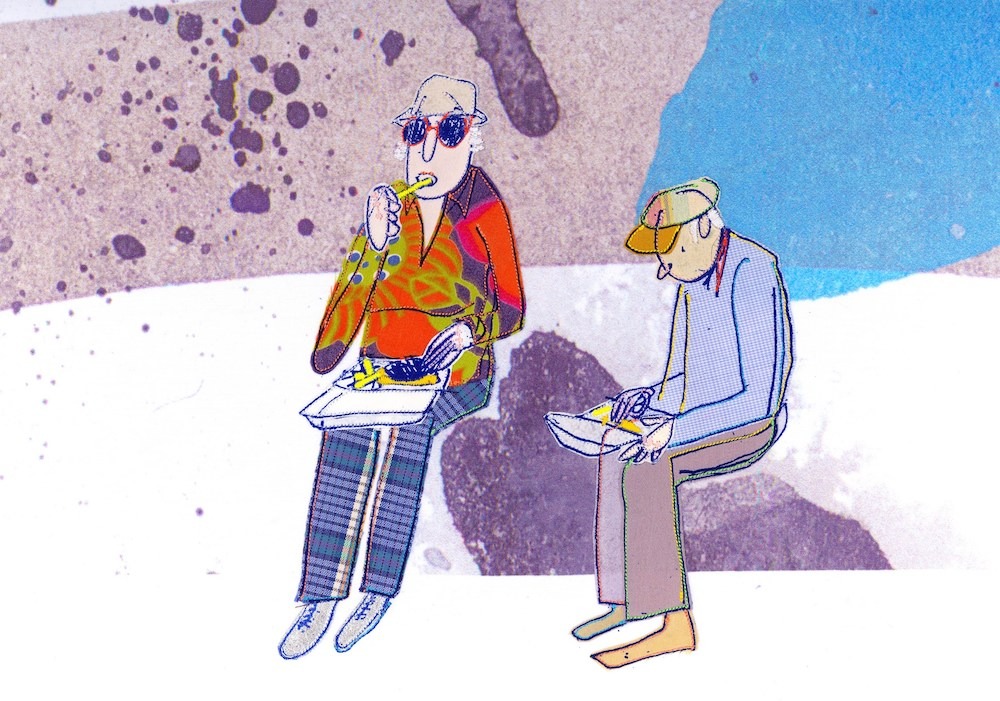
Digital and screen print, appliqué and machine stitch
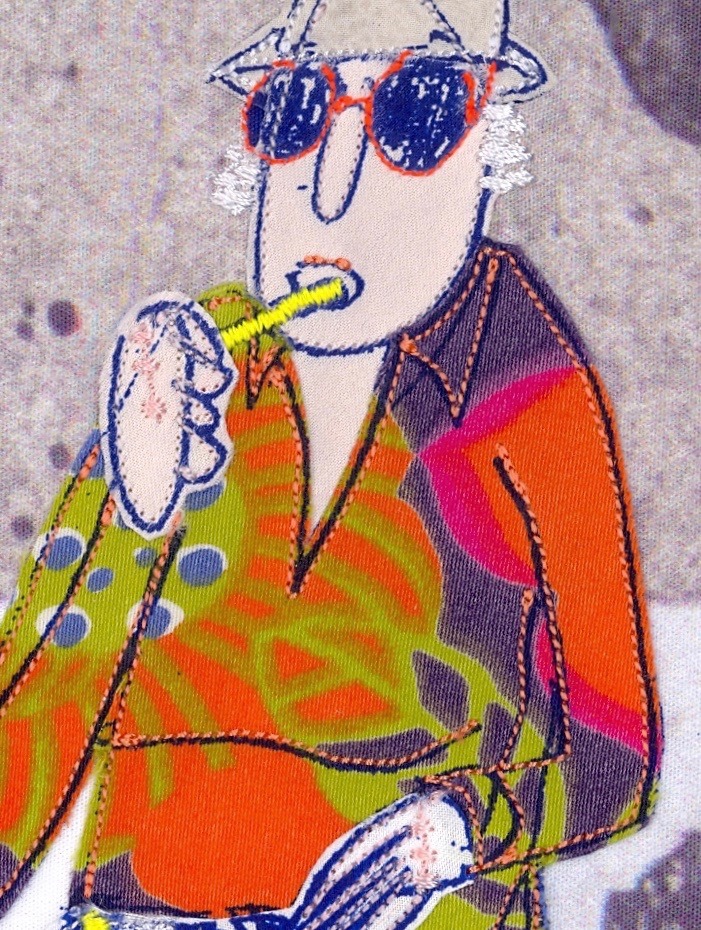
Digital and screen print, appliqué and machine stitch
An extension of play
Fish and Chips depicts a couple who have found a good spot on the beach to eat their fish and chips.
I love to dress my characters. I draw from life so I am influenced by the actual outfit a person is wearing, but I also add my own interpretation and have fun selecting suitable fabrics to appliqué.
In Fish and Chips the lady is wearing a lovely patterned blouse. The fabric I used was from a blouse of my own; it was just the right colour and pattern for her. Her blouse is teamed with a nice pair of checked trousers.
Her husband is more mainstream, wearing shades of grey and beige.
The digitally printed backdrop depicts the rocky landscape of the beach.
When I was young I loved playing with cardboard cut out dollies and dressing them with paper clothes; my work feels like an extension of this.
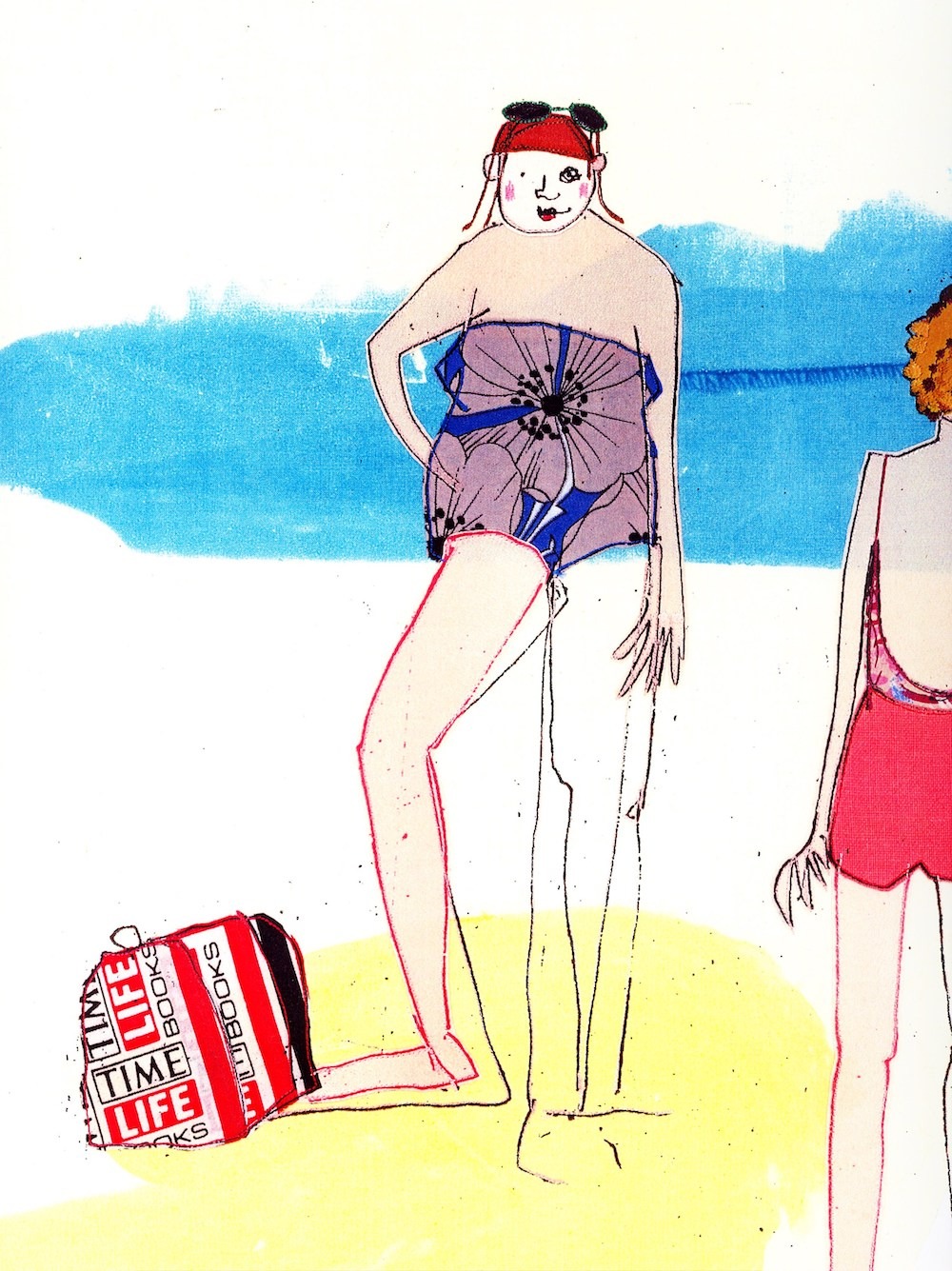
Screen print, appliqué and machine stitch
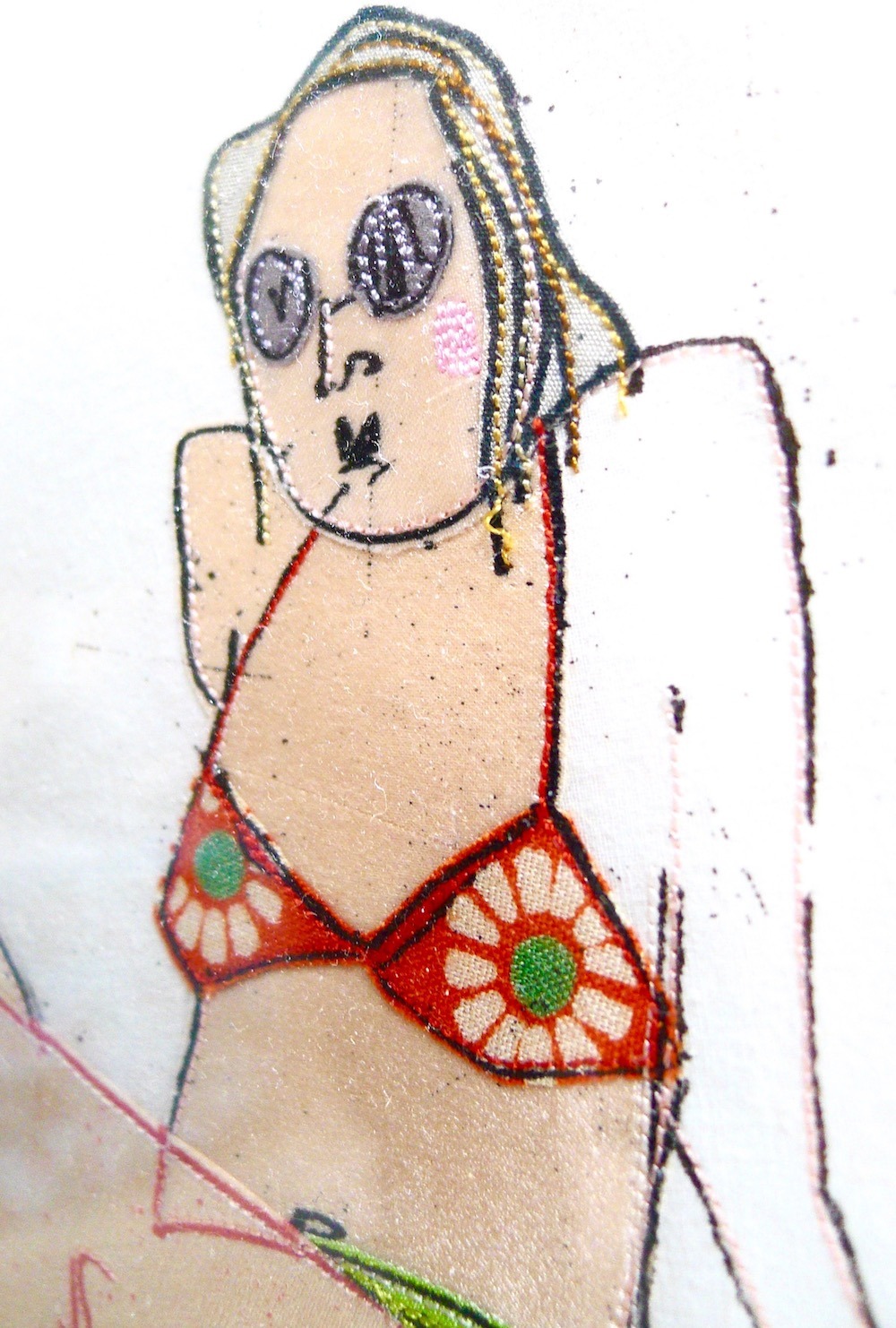
Screen print, appliqué and machine stitch
Creating light and dark
I made a series of Sunbathers pictures with applied satin fabrics depicting varying shades of flesh colour. By placing the satin silk in different directions, effects of light and dark are created.
The lady’s swimsuit fabric is an area cut out from a large 1960’s floral print scarf. The print seemed to suit the bold personality of the sunbather who has found her spot on the beach and is ready to settle down.
The swipes of screen printed blue and yellow depict the clear blue sky and sandy beach; all set for a few hours basking in the sun.
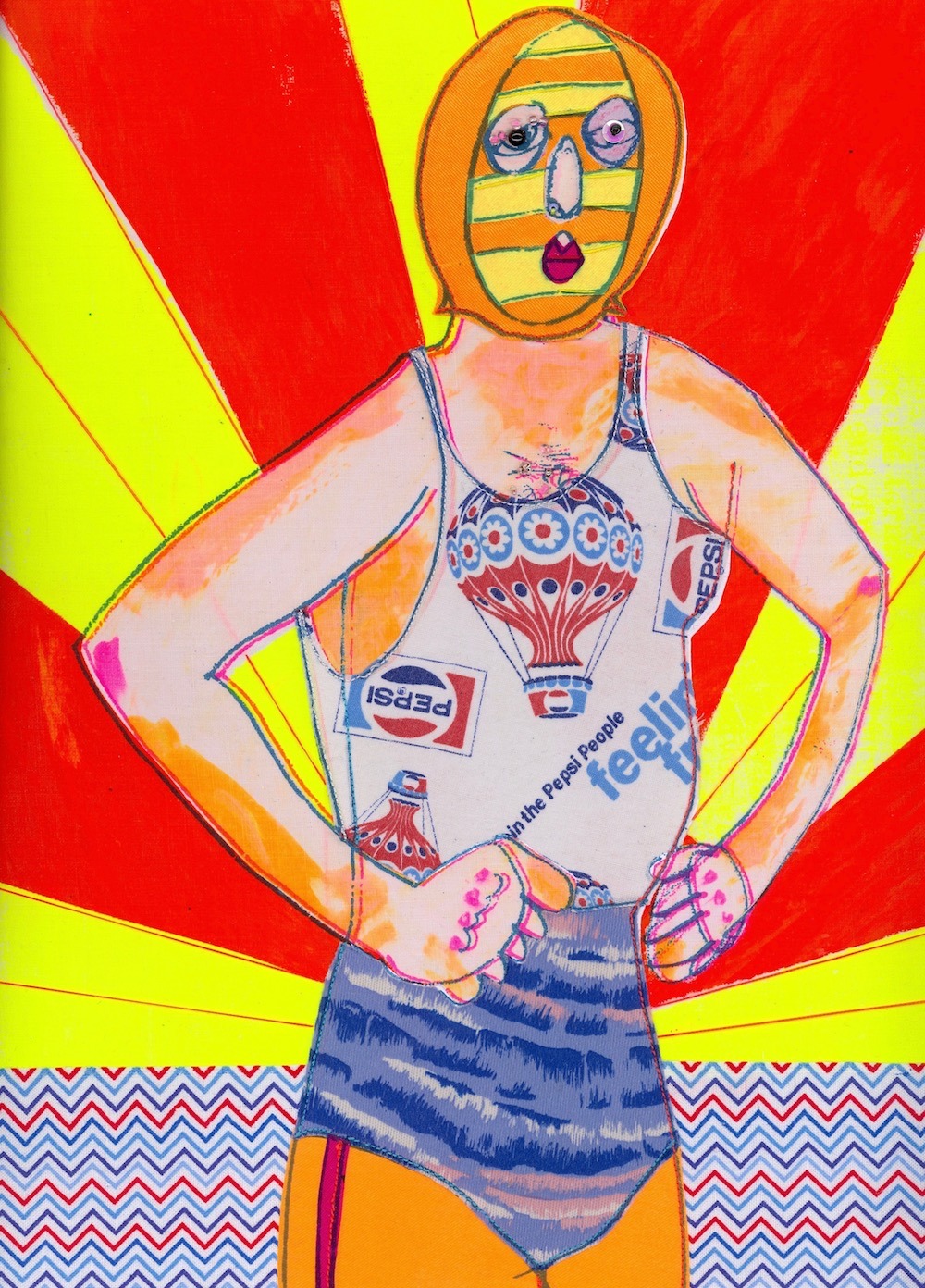
Screen print, appliqué and machine stitch
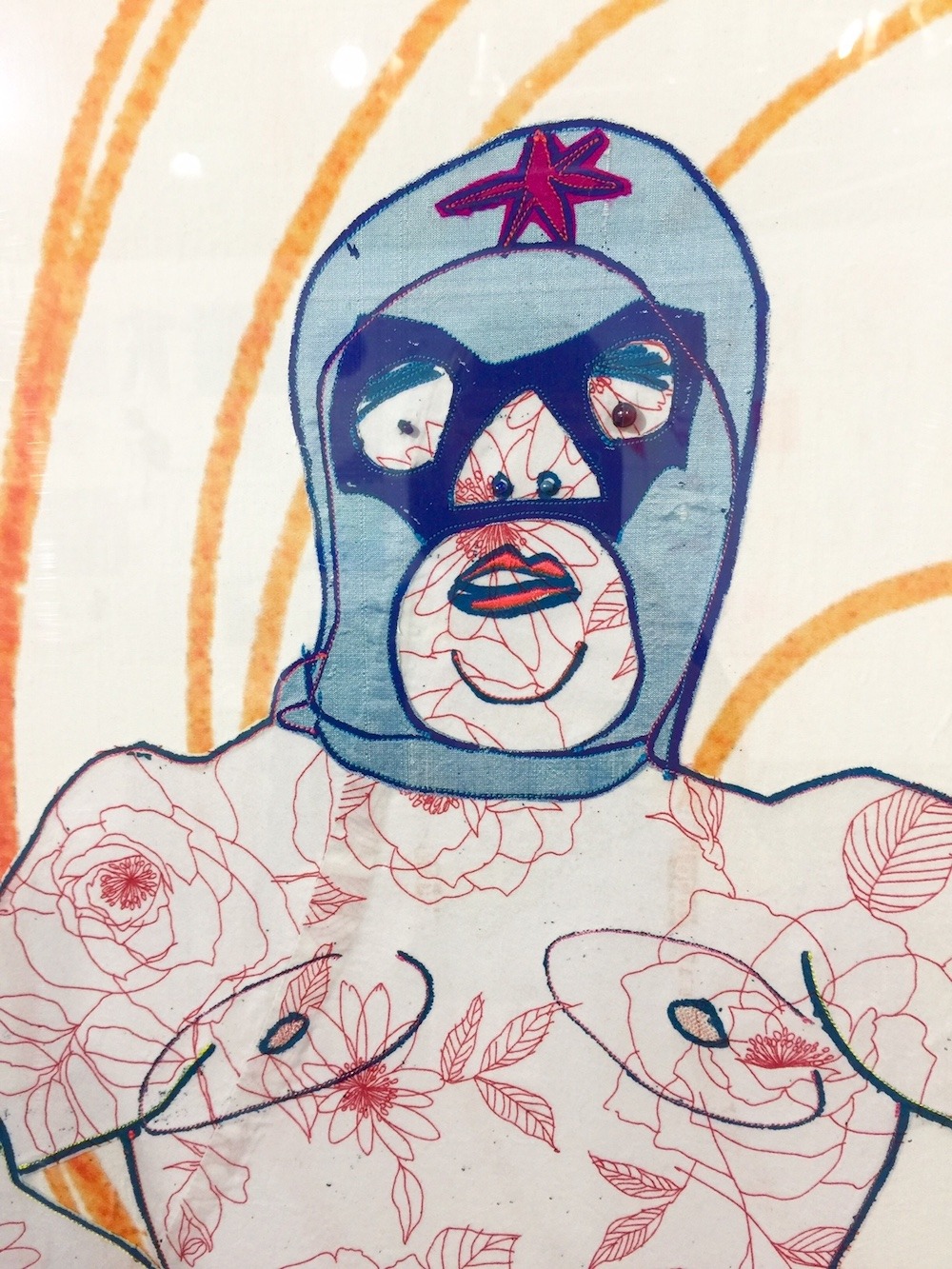
Screen print, appliqué and machine stitch
Fascinated by colour
I drew a series of Japanese wrestlers because I was fascinated by their colourful masks and outfits.
I like to use printed text in my appliqué and found a good use for some in the wrestler’s vest. The words on the vest say “Feelin’ Free”, which seems to be the opposite of how the nervous wrestler looks and probably feels.
His shorts are a type of blurred stripe, which adds to the feeling of uncertainty.
In the detail Wrestler II, I have had fun using floral fabrics for flesh.
Website: rachaelhoward.com
Louise Baldwin
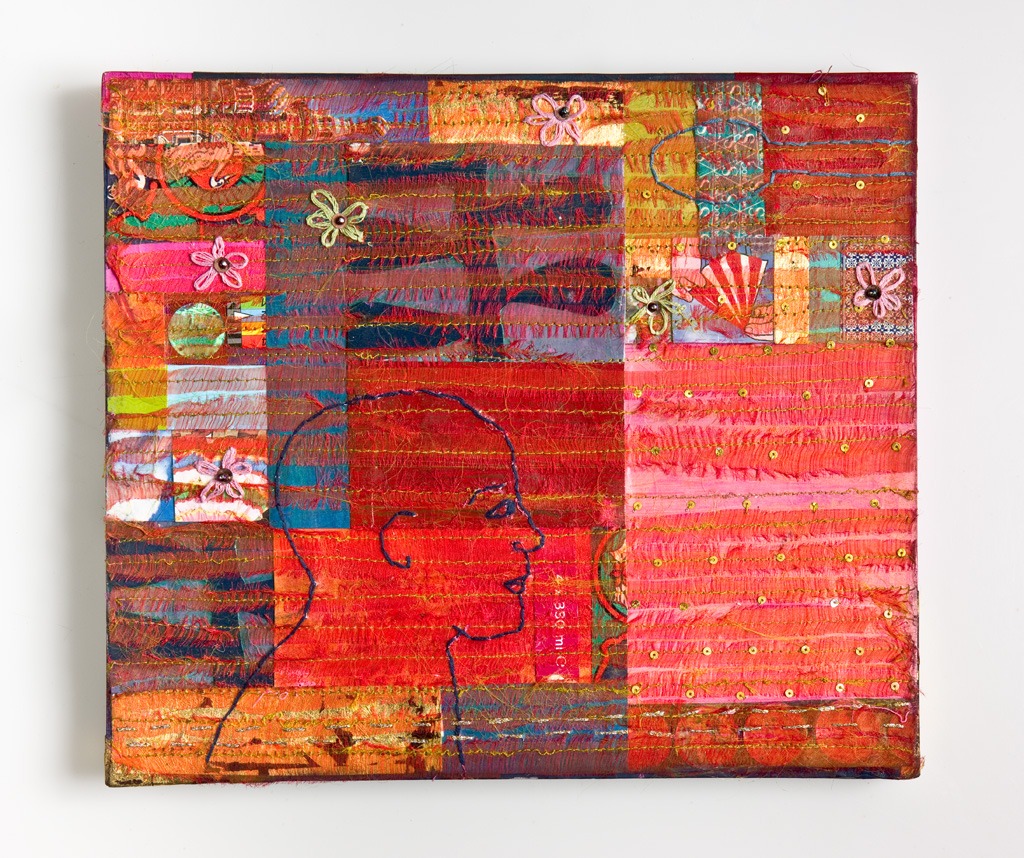
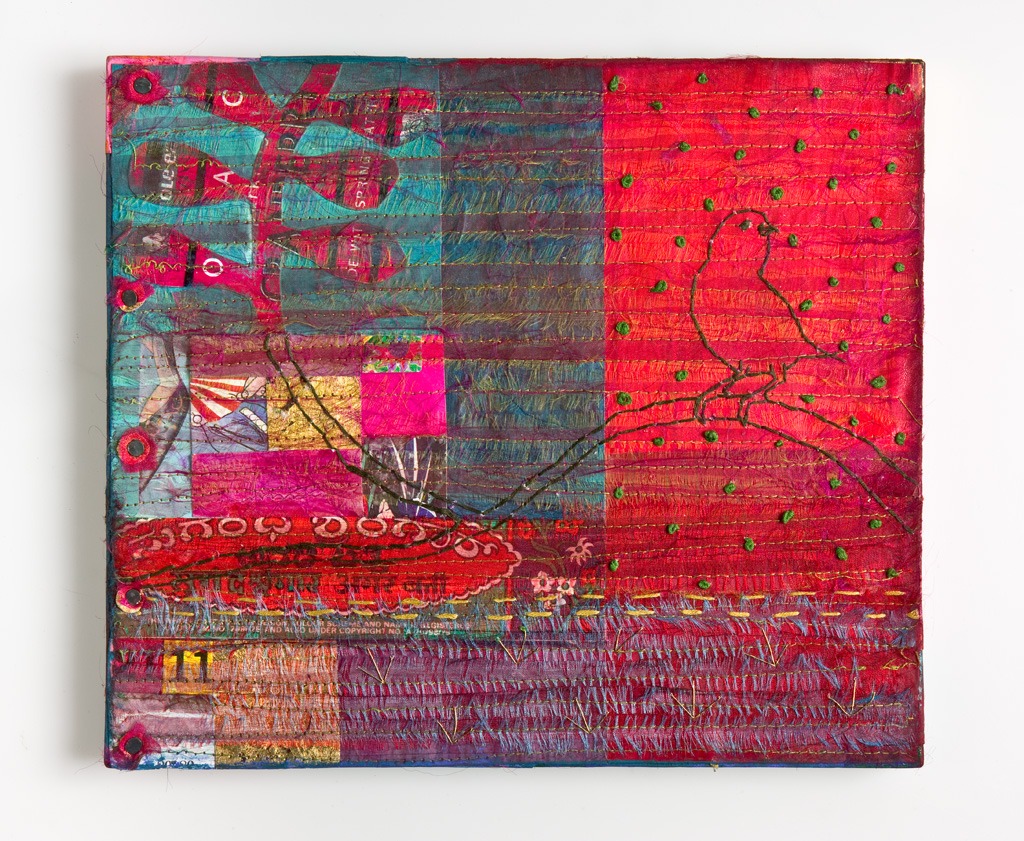

Do I use appliqué?
Louise Baldwin: I tend not to think much about technique. For me, it’s more about the process of making and the creation of an image.
I studied at Goldsmiths way back in the 80s when it was buzzing with creativity; you learned how to think and be resourceful. I’m not sure I really knew what appliqué was until much later, so I still think of it as collage but with stitch. And that’s why I love it!
With appliqué/collage I can respond to the physical immediacy of bringing together odd images, pattern and words; they take on a new meaning when they are thrown together.
The pleasure of colours knocking up against each other in an ‘accidently on purpose’ way brings out new ideas and unexpected results.
The work of artists like Rauschenberg and Jessica Stokholder seems to express an almost childlike pleasure in handling materials that is so uplifting and humorous. At my best and most relaxed I try to work like that.
About 15 years ago I started making pieces from domestic packaging; old bits of boxes and wrappers, tea bags, medicine, the dog’s biscuits were all great. These items formed a base of jumbled mundanity that was stitched over with images of optimism like flowers and birds. Our lives layer up and get complicated but we can still dream. Life is strange.

A jumble of materials
This is a recent little collage where I’m just pushing together all sorts of scraps picked up from the studio floor and stapling them together to make a relief form.
I love the physicality and lack of hierarchy that this way of working presents; a piece of cashmere against a bit of old bill board poster. No material is of greater value than another. It is I suppose representative of the jumble of sounds, images and emotions that we rub up against every day.
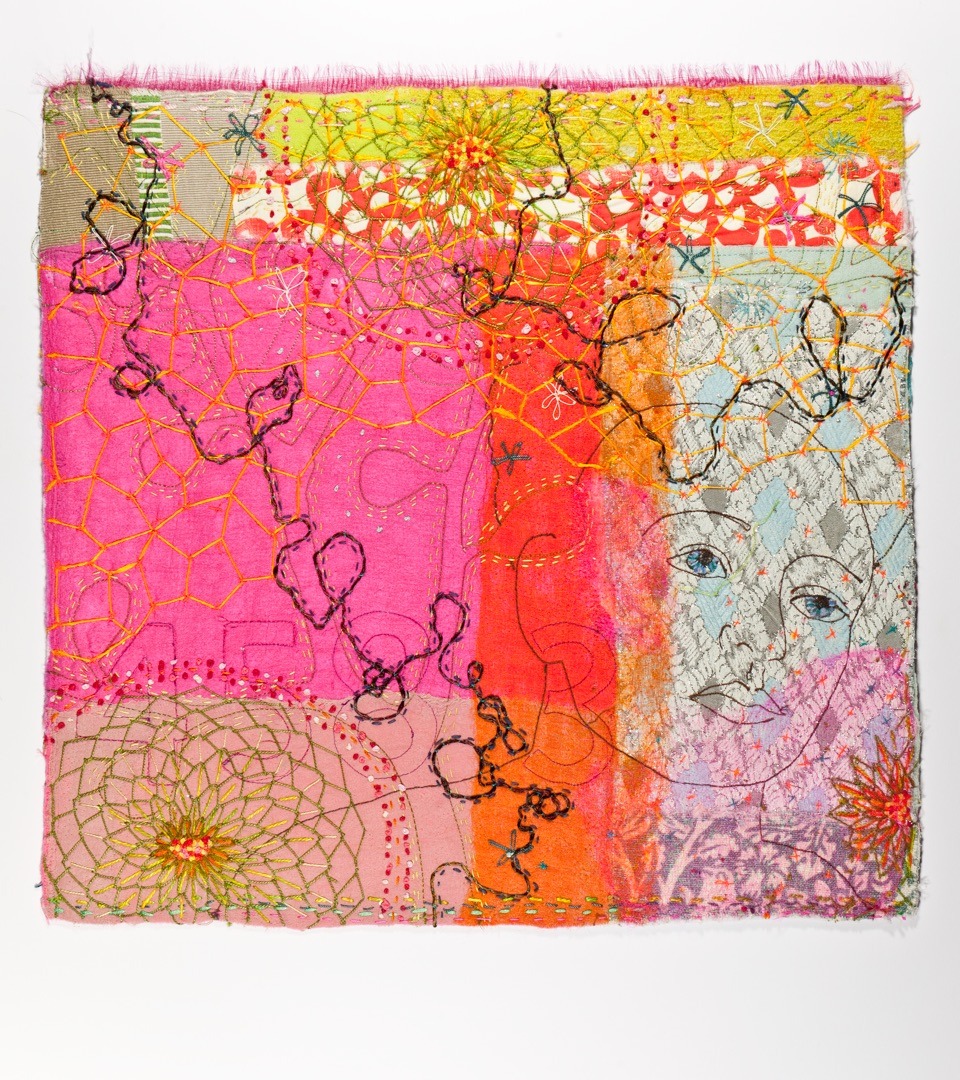
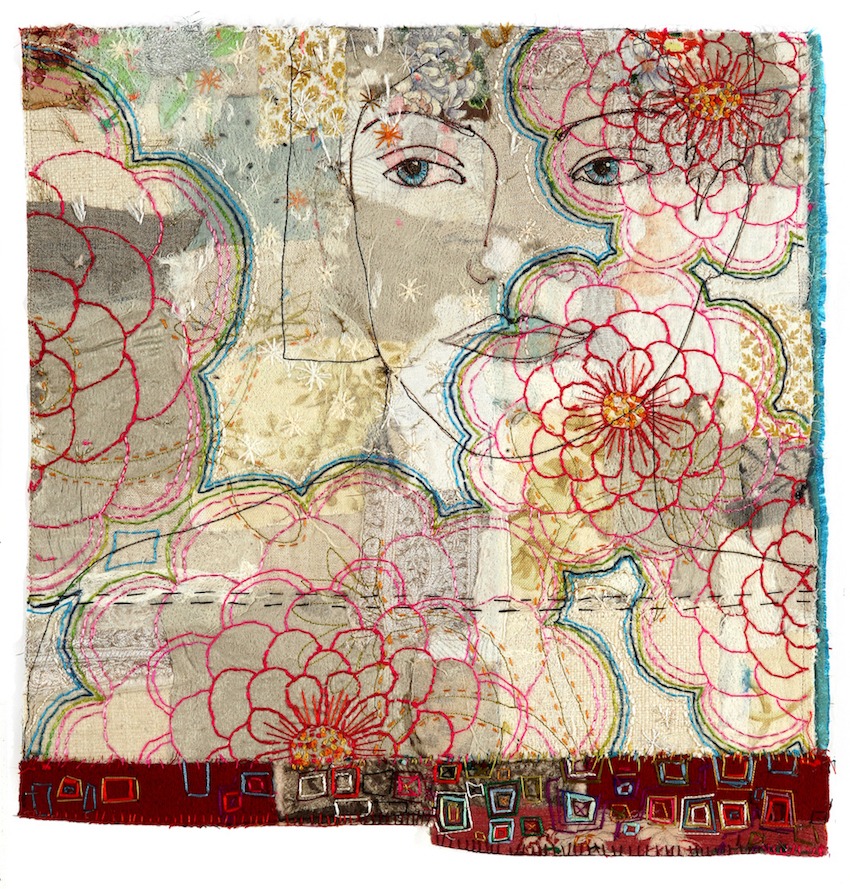
Untraditional applique
Over the last few years I have been using the embellishing machine as my glue and this is where my work really does become an appliqué of sorts.
Scraps of fabric are embedded into a support fabric, building up a surface that has some sort of energy. It becomes a fairly abstract composition that creates a mood.
Over the top come more specific stitched images; heads, plant forms and, more recently, urban marks and shapes extracted from graffiti. These stitches help to secure the materials but don’t follow their shapes as they might in traditional appliqué.
The image is unplanned and develops throughout the process of making. As a result, it takes a long time and many versions before a piece is completed.
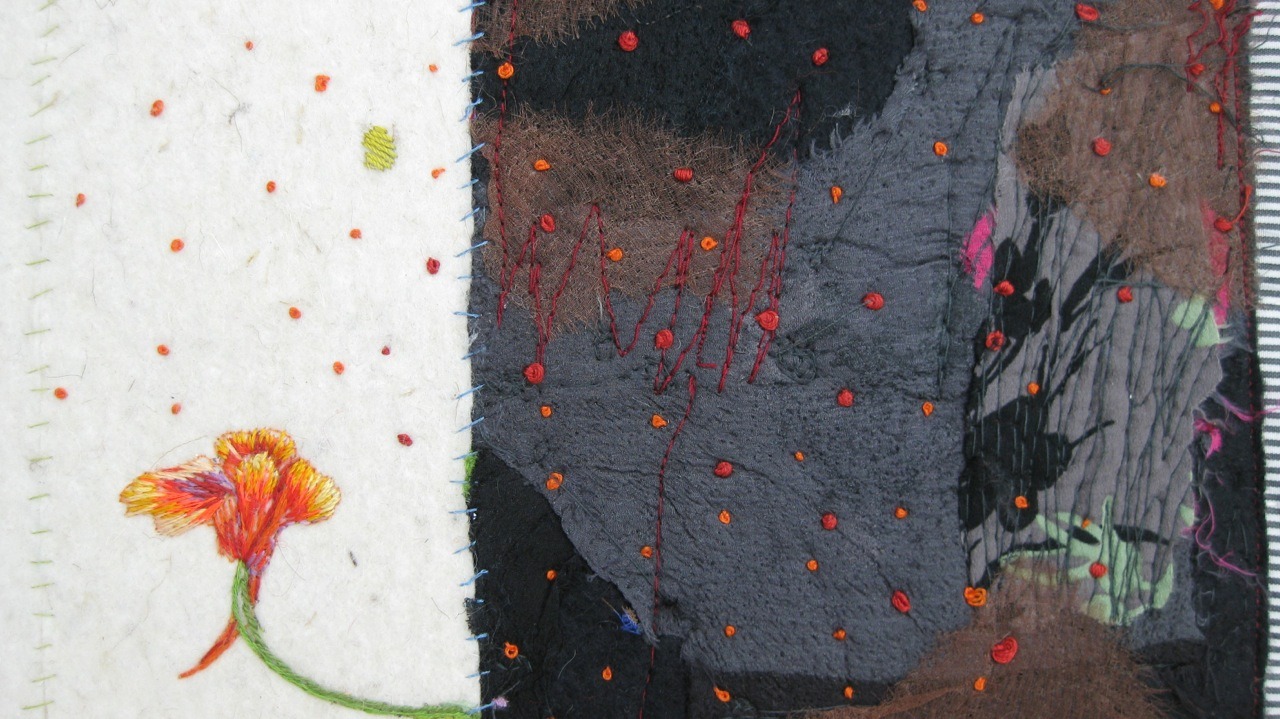
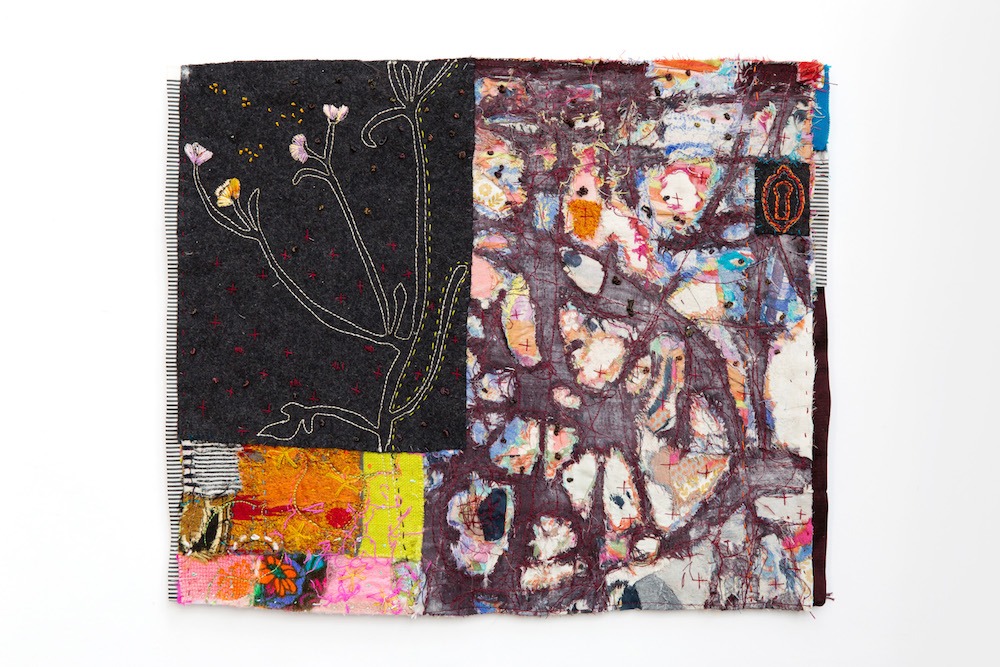
Concealed fragments of cloth
In the pieces Nasturtium and Over There, I was interested in revealing concealed fragments of cloth to create imagery reminiscent of worn paint and urban decay; these excavated surfaces were also built up with additional fabrics in an instinctive and roughly stitched way.
Both adding and taking away to create an image gave it a strong physical presence. I found a contrast with simple line drawings of fragile plants.
The way that I worked led me to question our individual perception of particular spaces and events; what catches the eye of one person may not be seen or valued by another. I suppose that prompts the question I had at the start, “Do I use appliqué“?
See Louise Baldwin’s page on the 62 Group website
See more of Louise’s work in the TextileArtist.org article 6 artists using recycled materials
Sue Stone
Materials: cotton/linen zaikai fabric, linen window cleaners crib, stranded cotton, recycled clothing fabrics, acrylic paint, [easyazon_link identifier=”B00QY1LQIE” locale=”UK” tag=”wwwtextileart-21″]Steam a Seam Lite (fabric fusible)
Techniques : hand stitch, machine stitch, appliqué, painting, fusing
Materials: cotton/linen zaikai fabric, linen window cleaners crib, stranded cotton, recycled clothing fabrics, acrylic paint, [easyazon_link identifier=”B00QY1LQIE” locale=”UK” tag=”wwwtextileart-21″]Steam a Seam Lite (fabric fusible)
Techniques : hand stitch, machine stitch, appliqué, painting, fusing
Creating texture
Sue Stone: Inspired by Gilbert & George’s self portrait We this is a portrait of my immediate family.
I chose appliqué to create areas of flat colour to stitch into because it is a very quick way to get colour into a large piece of textile art.
For Family Portrait I used areas of applied recycled clothing fabrics, including old denim jeans, linen trousers, and wool jumpers that had been shrunk in the wash. Some have also been stitched into to create pattern & texture.
Dan’s jumper (top left corner) has been applied using an old jumper. And then a hand stitched pattern was added, using off-white crewel wool, given to me many years ago by a friend who was clearing her studio.
Eli’s jacket (top right) has an applied background in navy with a textural pattern added using straight stitches in different shades of blue.
My scarf (foreground) has been made by applying several different colours using a fabric fusible[easyazon_link identifier=”B00QY1LQIE” locale=”UK” tag=”wwwtextileart-21″] Steam a Seam Lite (fabric fusible) to form the pattern and was then unified by adding a simple machine stitch.
Materials: cotton/linen fabric, linen window cleaners scrim, stranded cotton, recycled clothing fabrics, acrylic paint, [easyazon_link identifier=”B00QY1LQIE” locale=”UK” tag=”wwwtextileart-21″]Steam a Seam Lite (fabric fusible)
Techniques : hand stitch, machine stitch, appliqué, fusing
Materials: cotton/linen fabric, linen window cleaners scrim, stranded cotton, recycled clothing fabrics, acrylic paint, [easyazon_link identifier=”B00QY1LQIE” locale=”UK” tag=”wwwtextileart-21″]Steam a Seam Lite (fabric fusible)
Techniques : hand stitch, machine stitch, appliqué, fusing
Echoing applied pattern with stitch
A Lot can Happen in Fifty Years is a portrait of my sister, Jean, first aged 17, then aged 67.
The clock on the wall shows 2.05 am, whilst the wrist watch is set later to indicate the passing of time. The side panels are made up from labels referencing personal, national and global events from the 50 year period .
This piece has fused fabric appliqué (using recycled clothing fabrics) to form the pattern in the background and also on the armchair. I then added machine embroidery to create more pattern and texture.
To form the pattern on the dress of the younger figure, I added some black fused fabric leaf shapes. I then stitched into the yellow fabric to echo the applied pattern.
The striped shirt is made from recycled trousers. The hair is made from fused applied fabric which I machine stitched into. And the clock is also applied to the background.
Materials: cotton/linen fabric, stranded cotton, recycled cotton &silk clothing fabrics, acrylic paint, [easyazon_link identifier=”B00QY1LQIE” locale=”UK” tag=”wwwtextileart-21″]Steam a Seam Lite (fabric fusible)
Techniques : hand stitch, machine stitch, appliqué, fusing
Materials: cotton/linen fabric, stranded cotton, recycled cotton &silk clothing fabrics, acrylic paint, [easyazon_link identifier=”B00QY1LQIE” locale=”UK” tag=”wwwtextileart-21″]Steam a Seam Lite (fabric fusible)
Techniques : hand stitch, machine stitch, appliqué, fusing
Simplicity of line
Less is more in this 2016 Self Portrait, which includes my signature fish, a symbol of my Grimsby heritage; I chose to use appliqué here to demonstrate this simplicity.
The hair is made from fused recycled cotton clothing fabric. I added stitched texture using thick and thin wool yarn and stranded cotton threads.
The dress is made from recycled denim. The prop is made from recycled cotton with added machine stitch. And the fish are made from fused hand dyed silk with added machine stitch.
Website: womanwithafish.com
Go deeper into Sue Stone’s process in the TextileArtist.org article From conception to creation
Ben Venom

Hand-made quilt with recycled fabric

Jean jacket with recycled fabric

Hand-made quilt with recycled fabric
Ben Venom: I use appliqué as the primary technique for the majority of the quilts and jackets I make.
The foundation of my designs is comprised of donated/recycled fabrics, which are then stitched onto larger pieces of fabric. It is basically one large appliqué puzzle piece that forms an intricate design when viewed from a distance.
Every single piece is individually appliquéd using my Juki sewing machine.
By appliqueing these donated fabrics into a unified piece, the quilts are able to display a multitude of personal histories. Everyone’s unexplained stain, tear, or rip will be included and, when displayed, visitors will be able to see a piece of themselves woven into this larger history. A collection of memories, dreams, and past experiences will be on view in the form of a functional quilt.
Website: benvenom.com
Read TextileArtist.org’s interview with Ben here
Susie Vickery
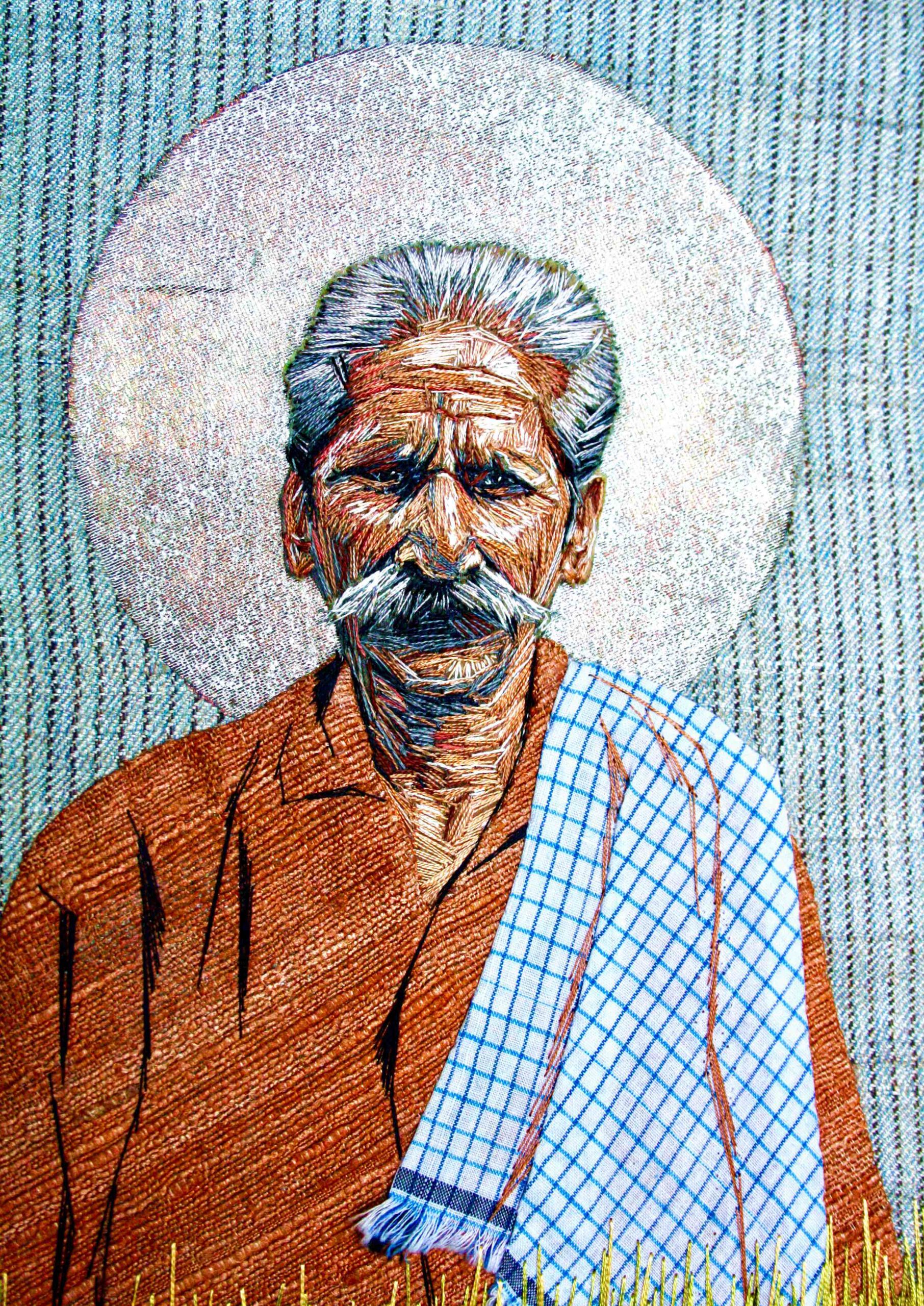
Selecting authentic fabrics
Susie Vickery: Icons of the Ordinary is a series of portraits of people from the southern Nepali town of Janakpur. The clothing of the subjects is appliquéd as flat shapes and then embellished with stitched folds.
The fabrics chosen were crucial. I used fabrics from Nepal that match the actual garments being represented; local cottons, silks and sari fabrics.
It was important that the very distintive fabrics were immediately recognisable for the particular garments. For example, the towel over the shoulder of Mulaha Mandal is made of actual towel fabric.
All of the Icons have a nimbus of appliquéd gauze overlaid with silver leaf. A lot of South Asian sweets are covered in silver leaf so packets are available in the little grocery shops.
The man in my local shop in Janakpur thought that I was eating a lot of sweets as I was always popping in for another packet. It was a challenge applying the silver leaf in the extreme heat of Southern Nepal. I had to turn off the fan so the leaf didn’t fly away and then try not to drip sweat onto my embroideries!
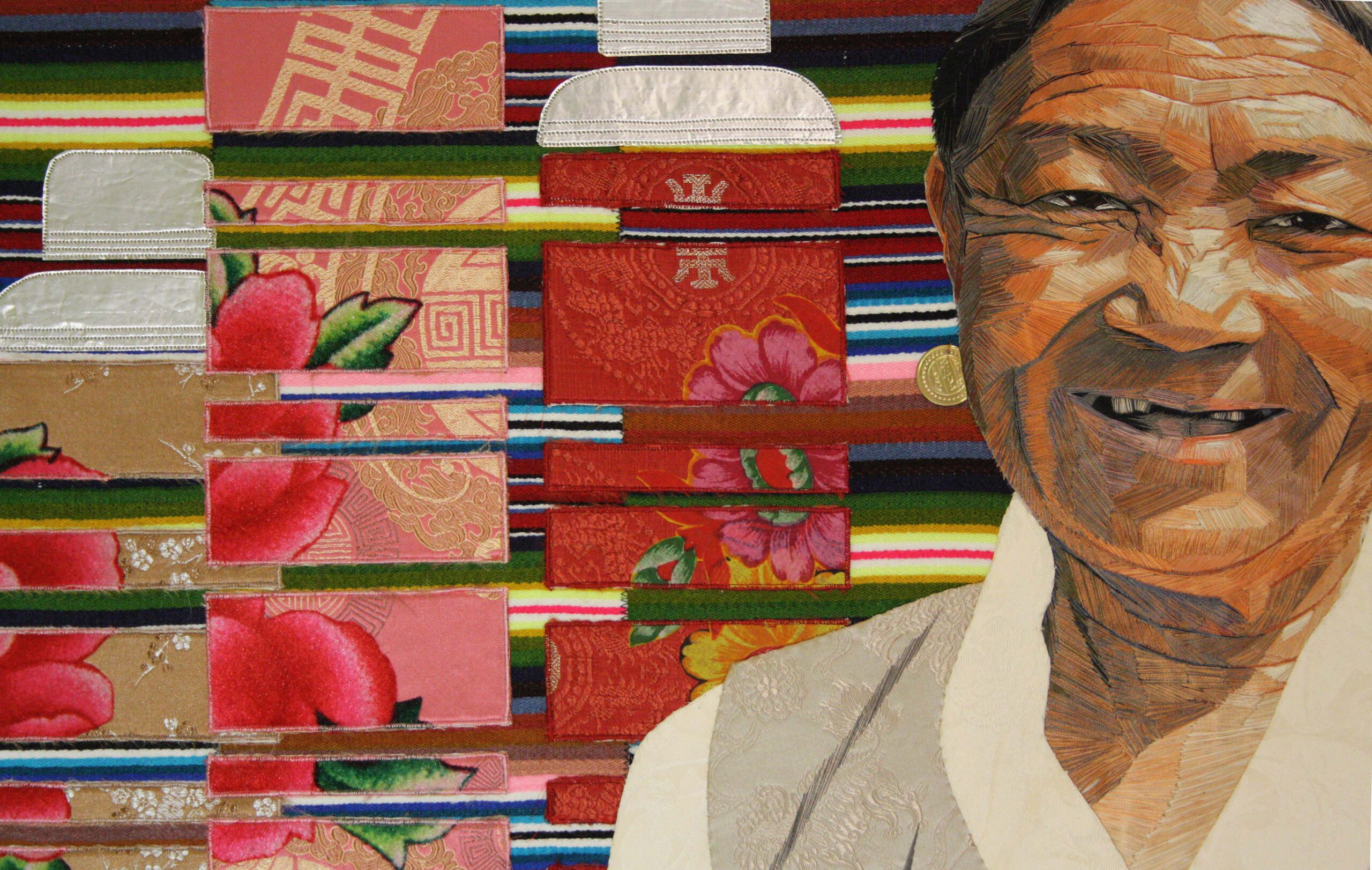
Recreating a distinctive identity
In Yak Butter Tea, the subject of the embroidery (my old Kathmandu Sherpa landlady) is wearing a chuba, the traditional Tibetan women’s dress. Sherpas are ethnically Tibetan even though they are Nepali, so they wear Tibetan dress, eat Tibetan food, drink Tibetan yak butter tea and speak a Tibetan dialect.
With such a distinctive identity it was important that the fabrics used were the real thing. So the appliquéd chuba is made of Tibetan brocade and silk blouse fabric with the folds of the fabric embroidered on.
In the Kathmandu markets there are lots of small shops selling brocades to be made into chubas. They also sell a lot of fabric especially for monks. Other Nepalis wouldn’t frequent these shops as they are seen as being especially for people of Tibetan ethnicity (and me).
Tibetans keep their yak butter tea in colourful Chinese thermos, usually decorated with large blowsy peonies, a very Chinese flower. I made the body of the thermos from Tibetan brocade and then over appliquéd flowers cut from another fabric. The tops of the thermos were made with sewable metallic sheets.
The background of the embroidery is made of Tibetan striped aprons, the most distinctive feature of Tibetan women’s dress. The offkilter stripes are supposed to ward off the evil eye from the woman’s reproductive areas.
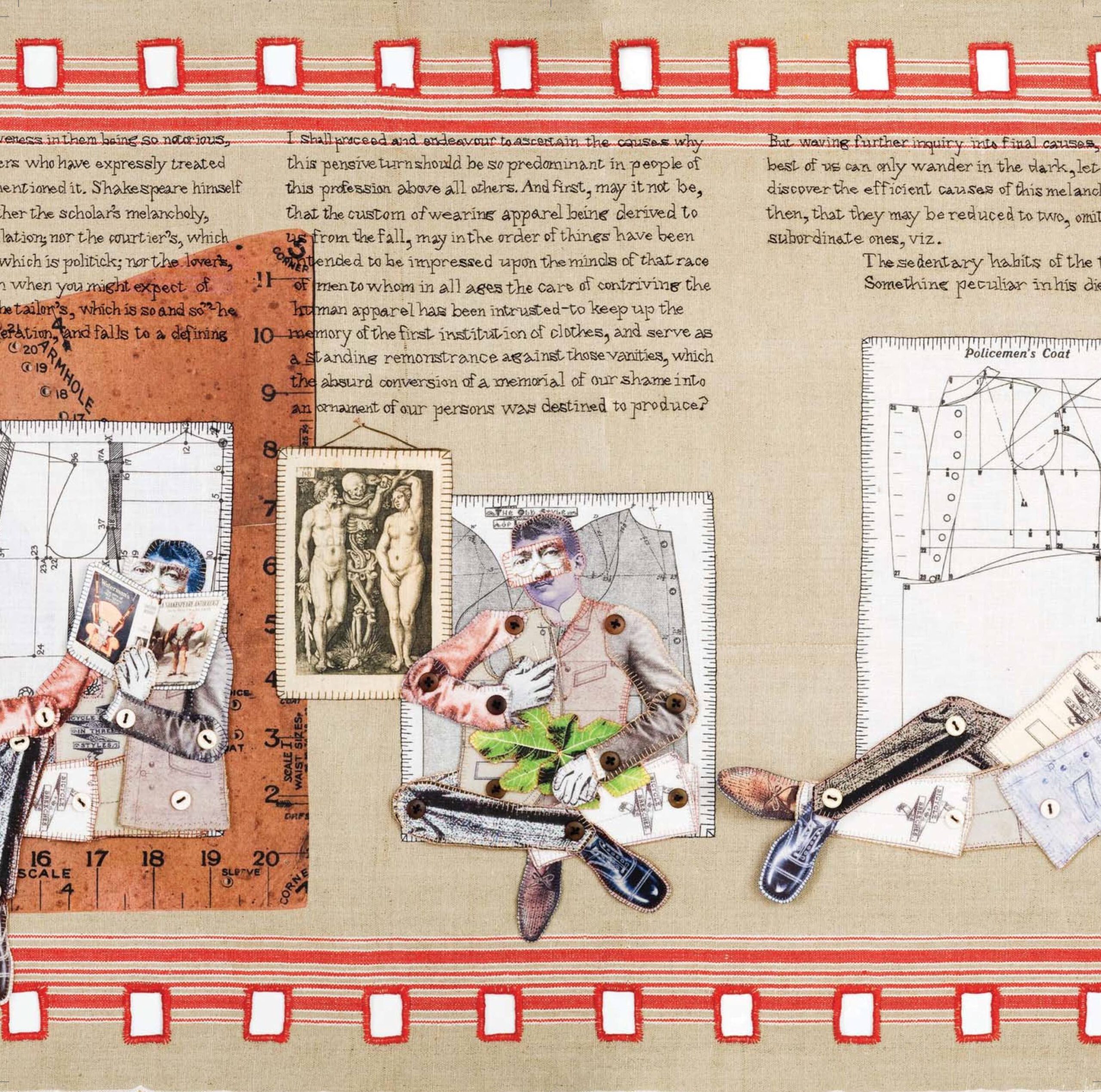

Personal history and story telling
On the Melancholy of Tailors has small puppets, made up of printed images of 18th and 19th century tailoring drafts. They are placed against background ‘scenes’ of the same sort of drafts. Each draft marks the next phrase in the essay. The drafts are from old tailoring books that I used in my previous career as a theatrical tailor.
I have appliquéd the scenes on using buttonhole stitch, a stitch I used frequently for the period coats I once specialised in.
There are quite a few props for the tailor as the essay progresses; a pram and a wife, a cannon, and most importantly cabbages. I printed these props onto fabric and then buttonholed them onto the background.
The background fabric is also embellished with a printout of a dressmaker’s sleeve curve, which belonged to my mother when she was a dressmaker. So all the appliquéd layers make up the story of my history and fit in with the subject of the essay; a tailor making himself melancholy by sitting for too long cross legged and eating too much cabbage.
Website: susievickery.com
Read TextileArtist.org’s interview with Susie here
Have an idea for how to use appliqué in your work? Share it with the TextileArtist.org community in the comments below.
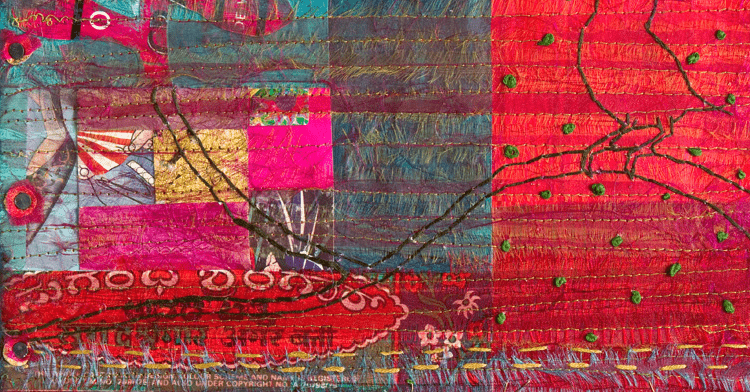
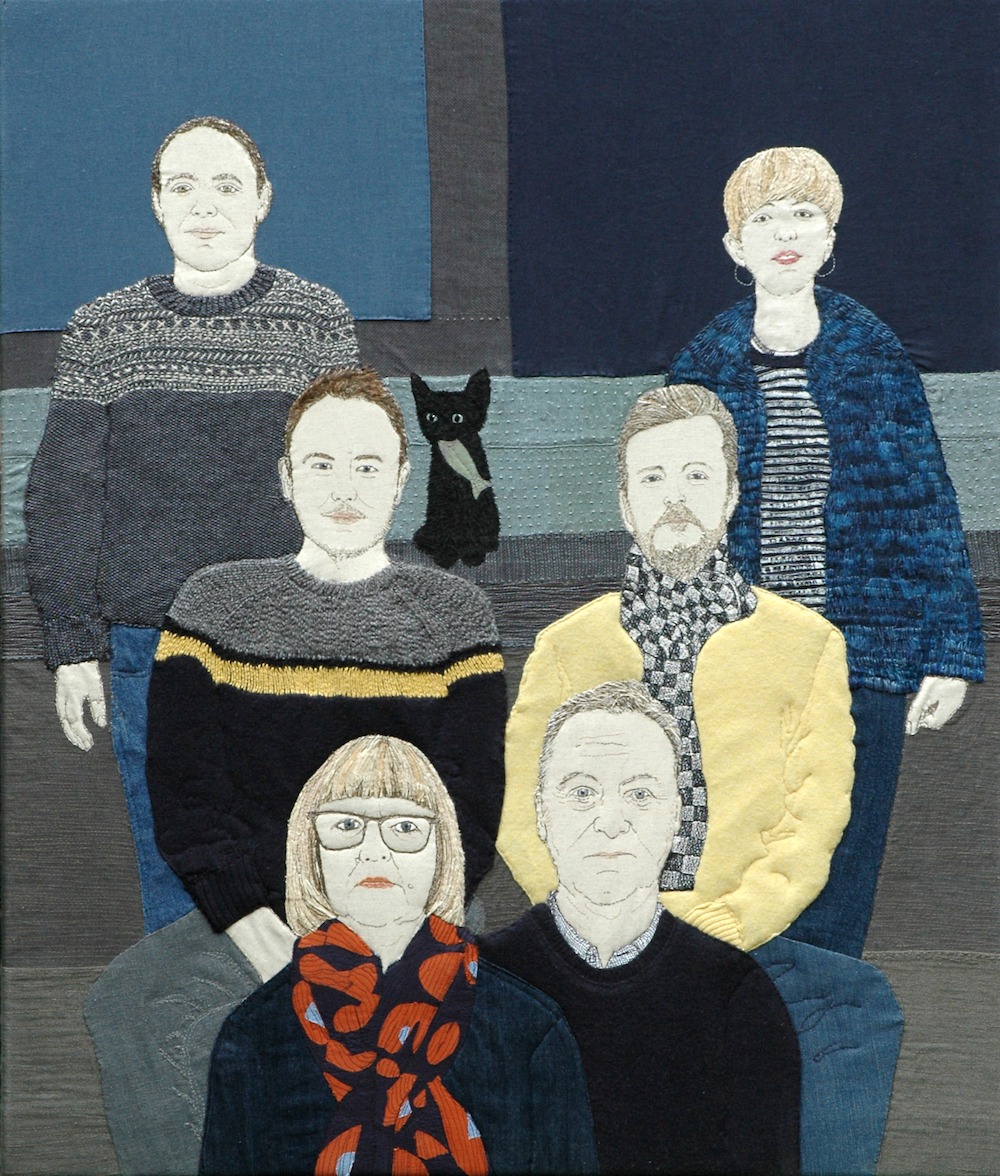
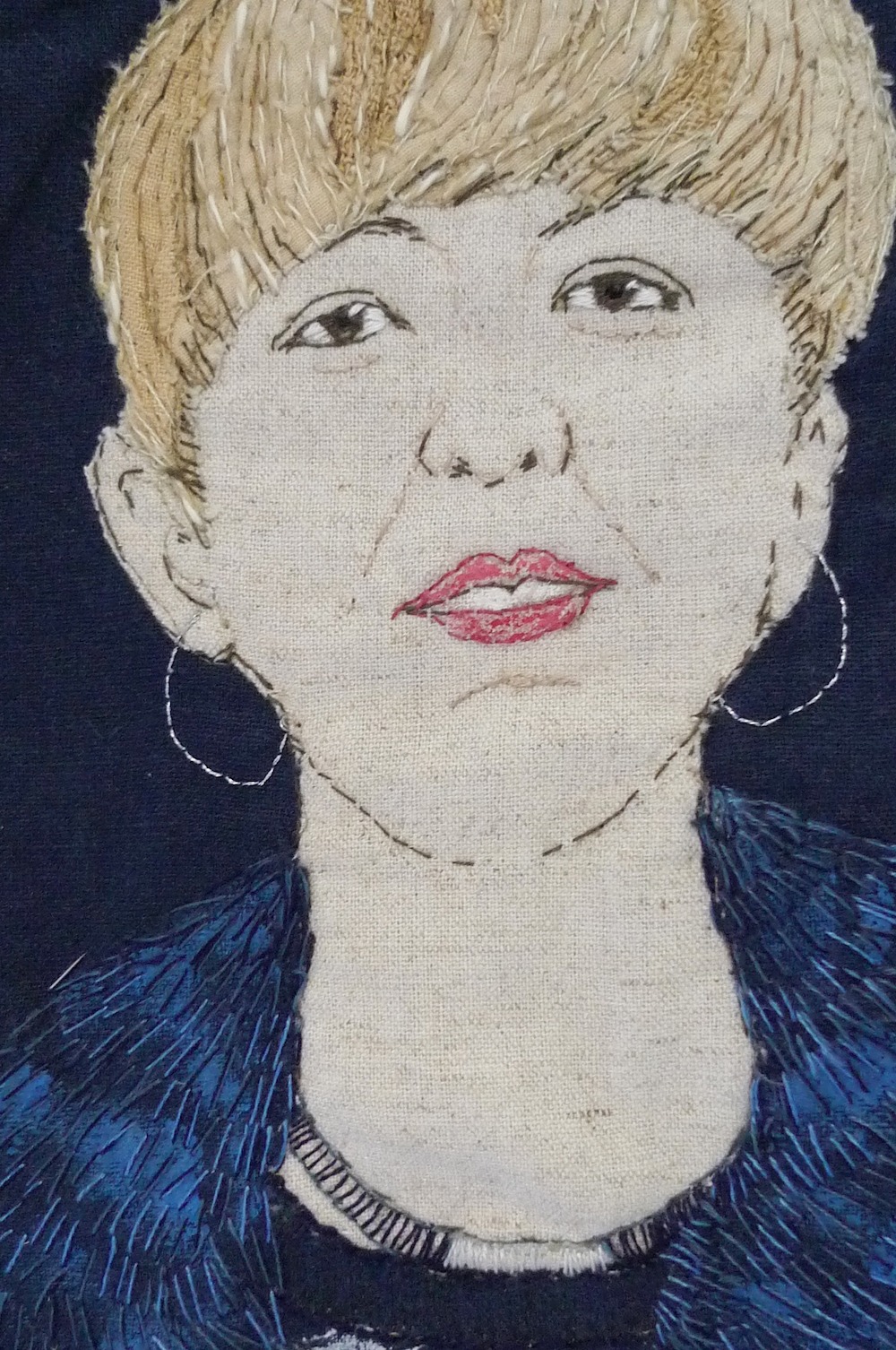
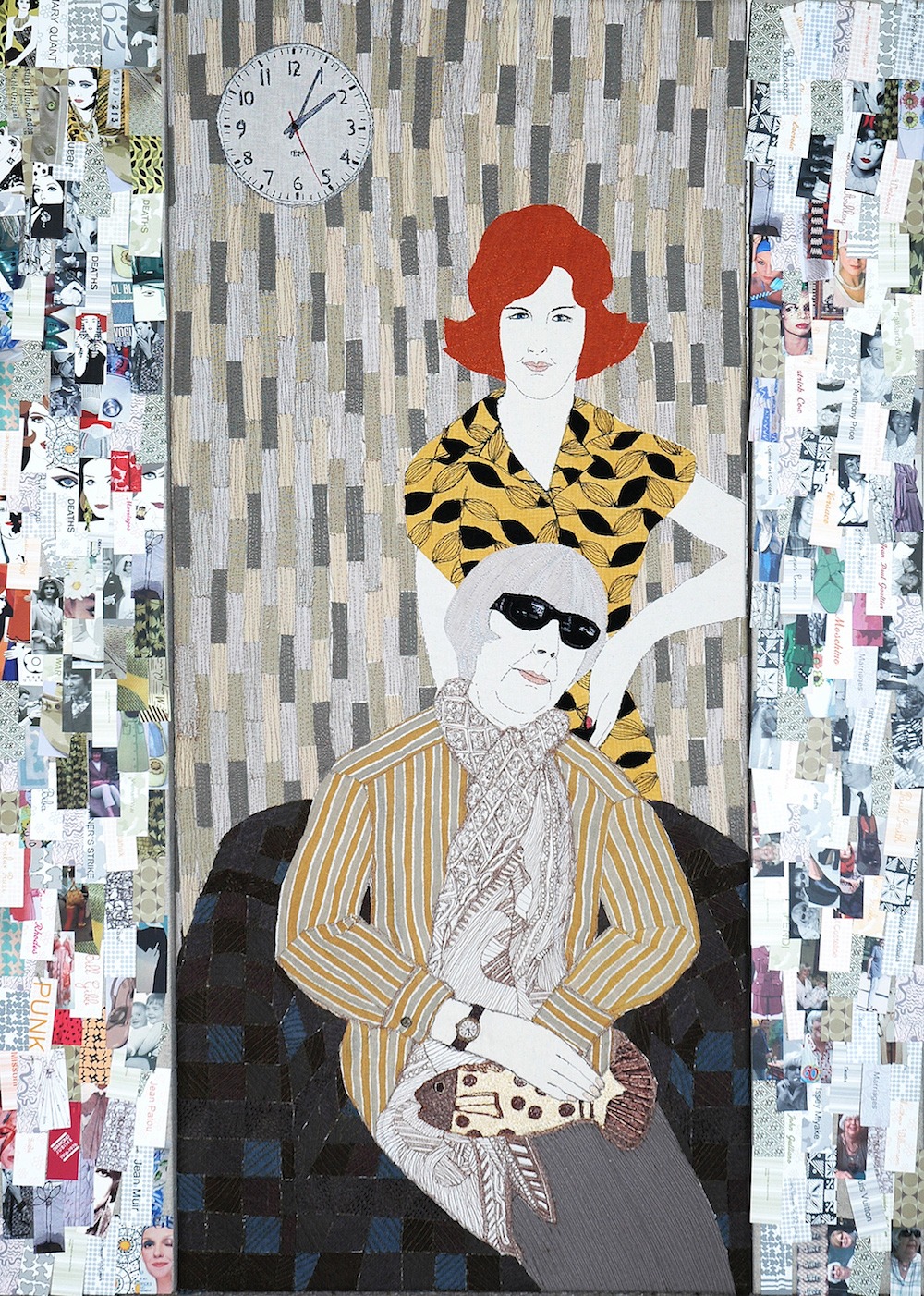
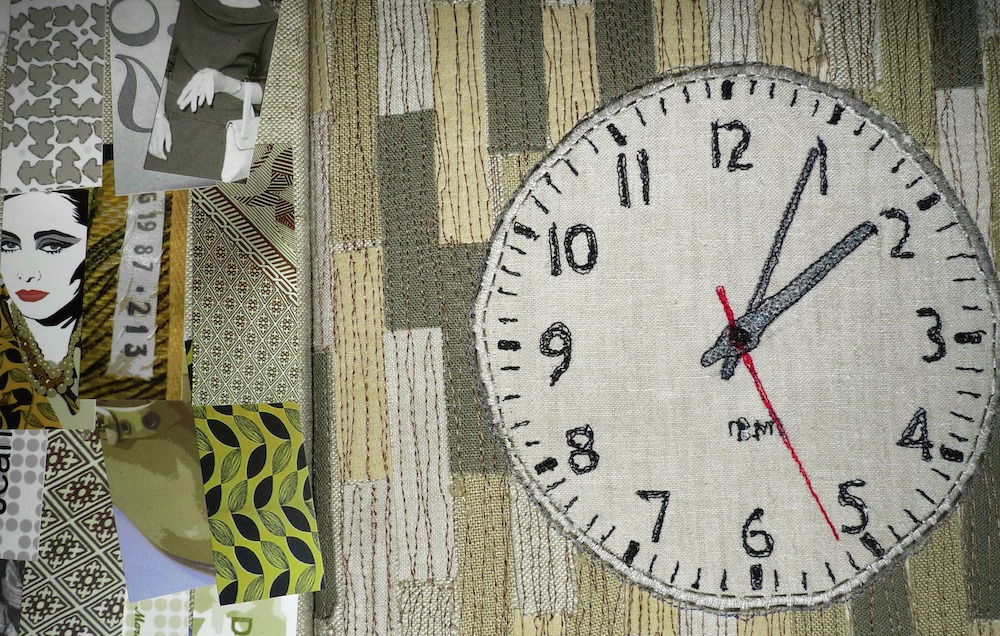
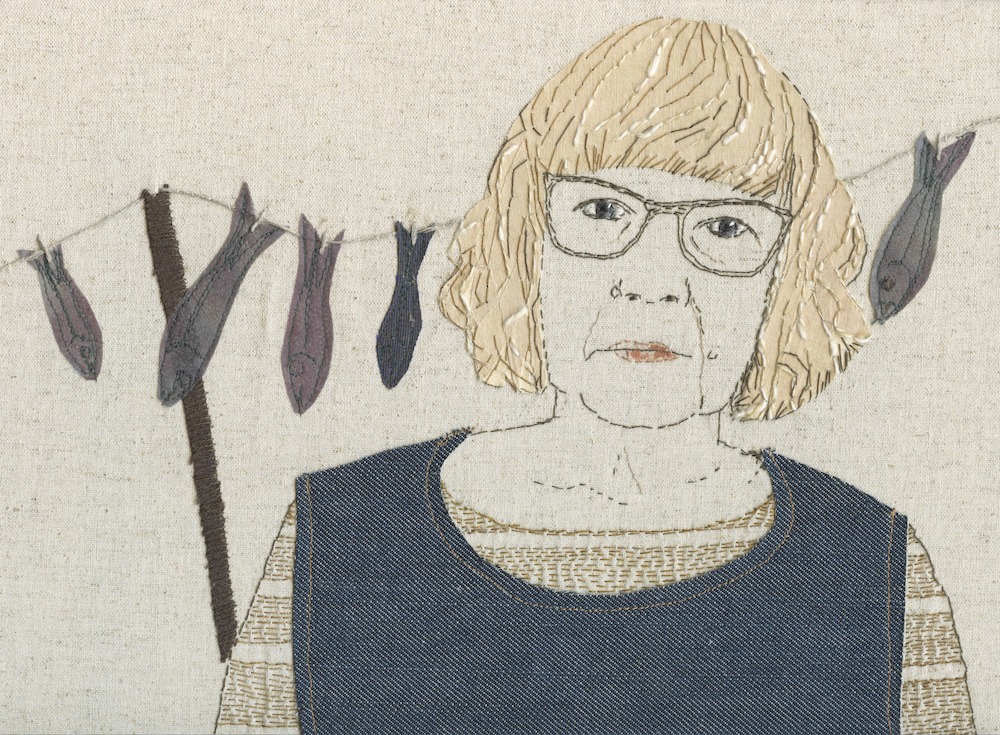
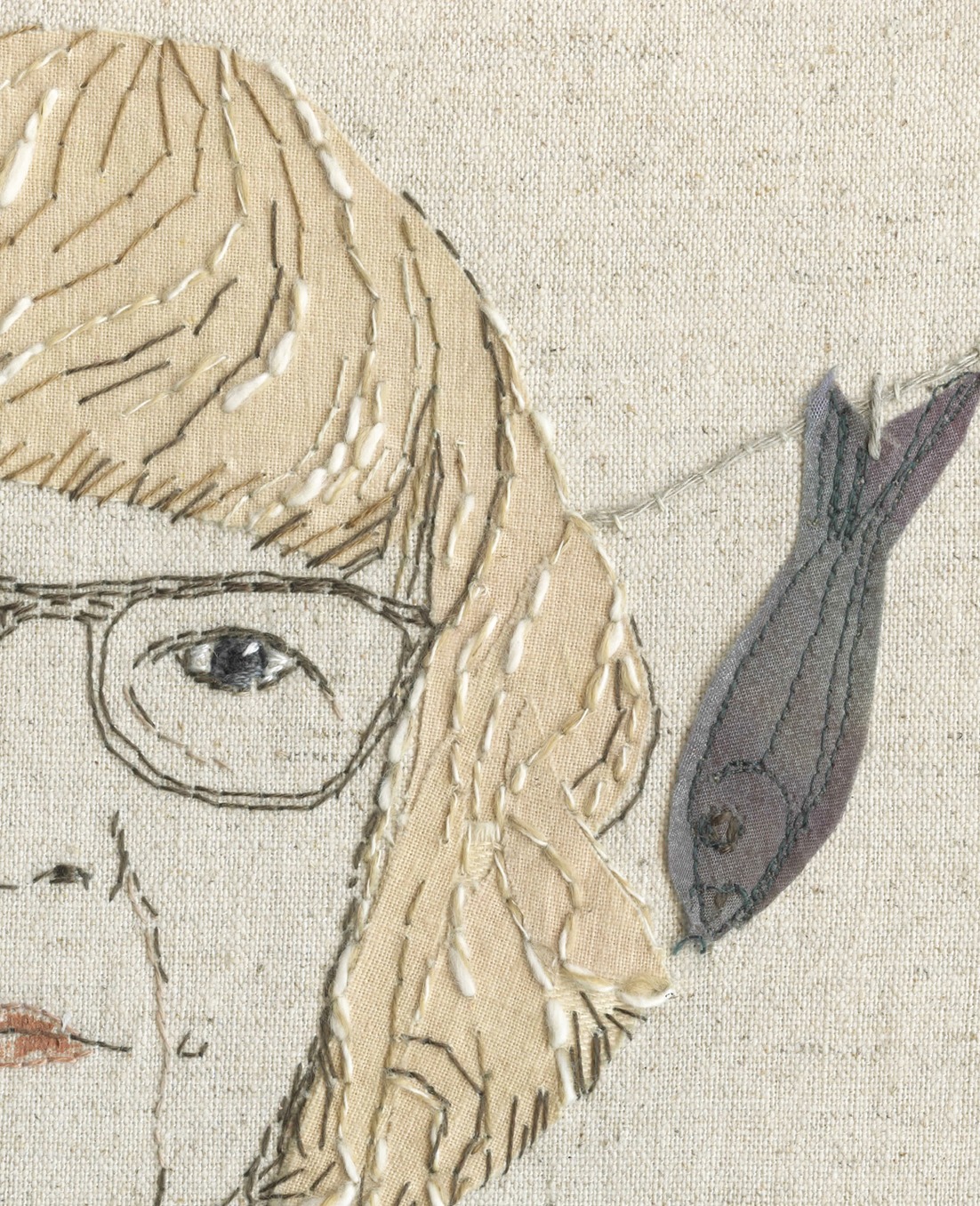
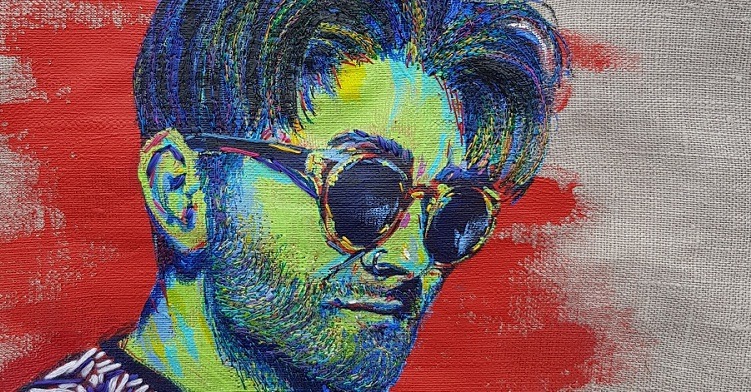
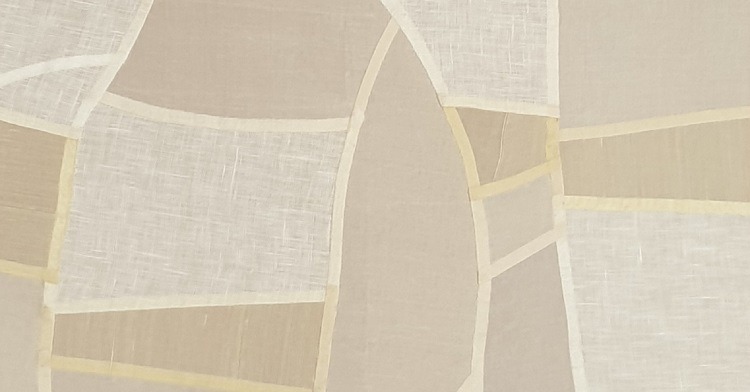
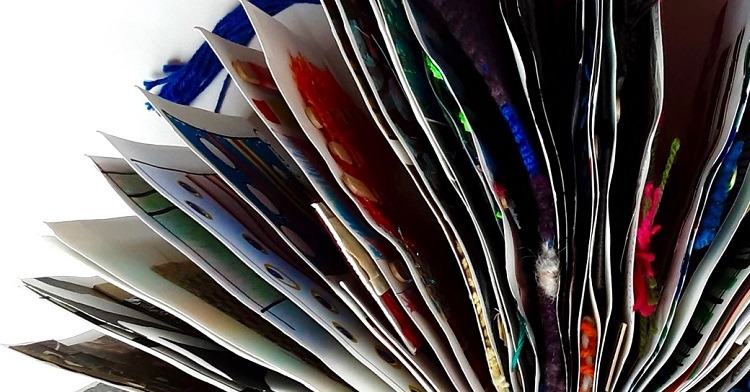
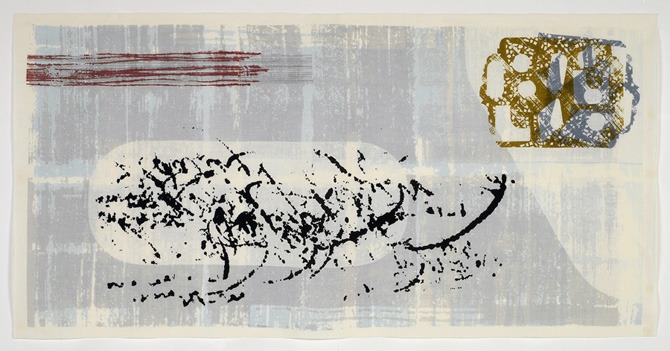
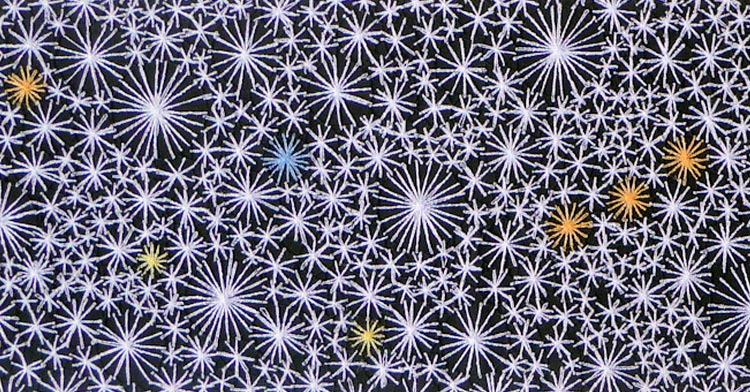
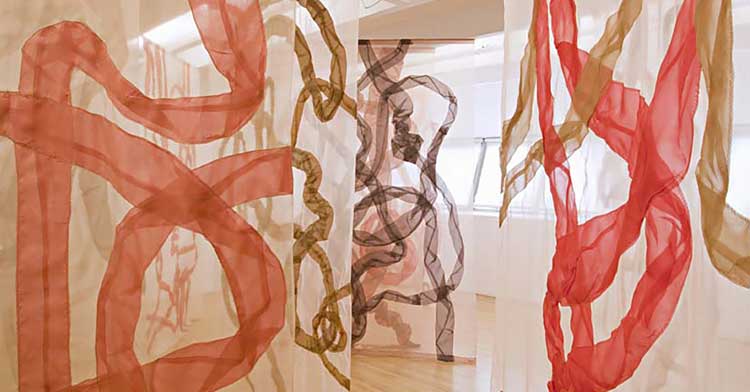

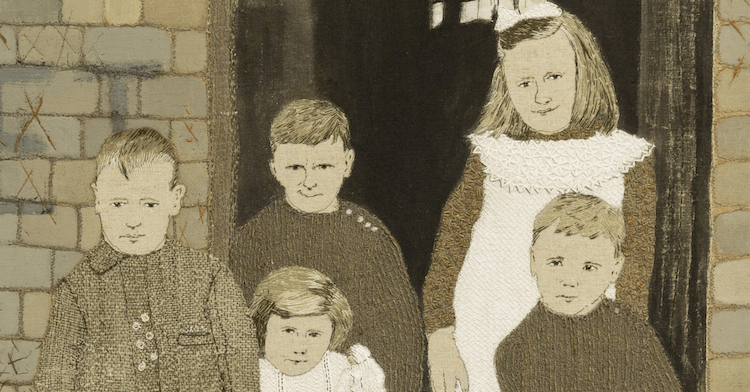
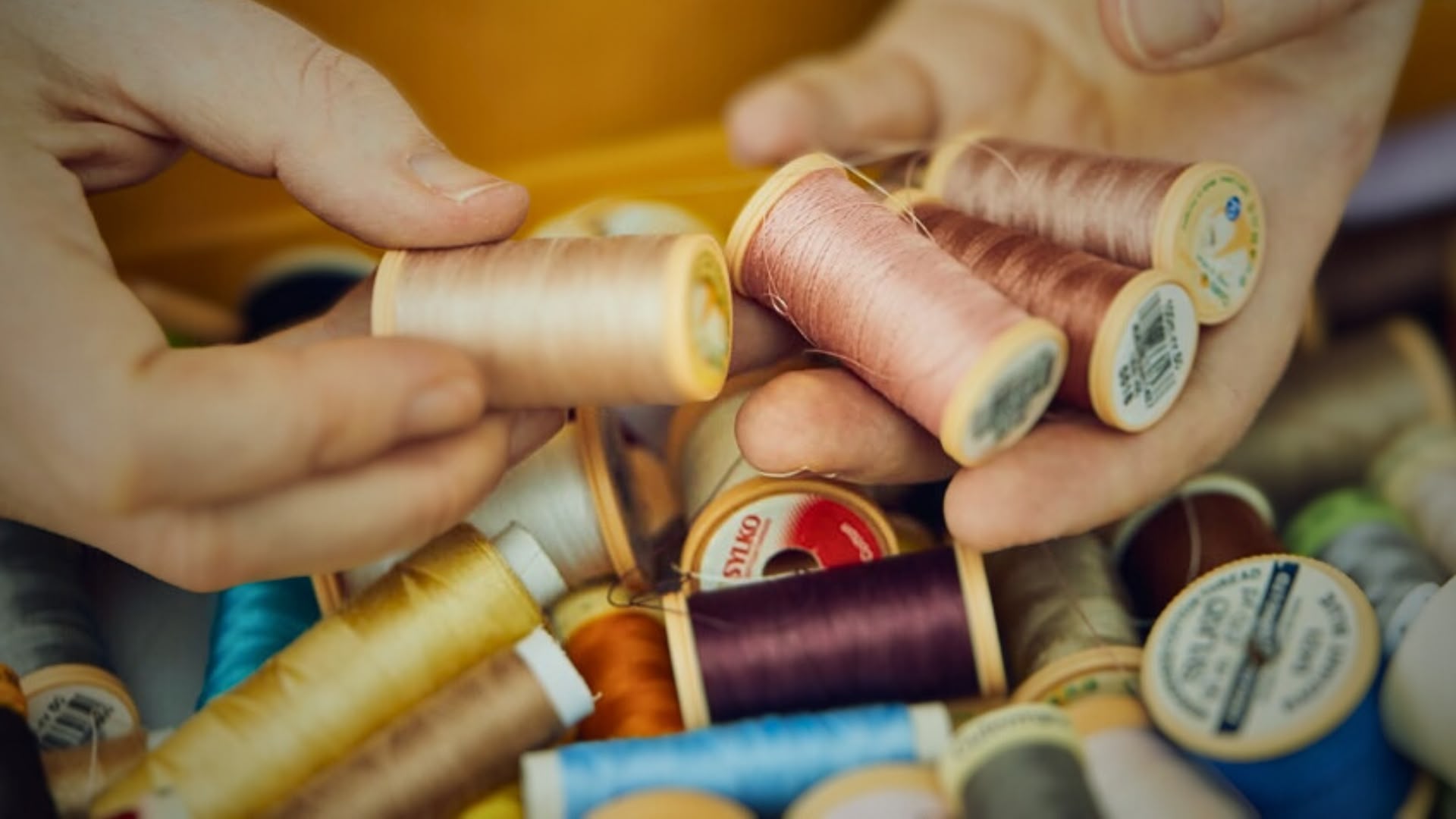
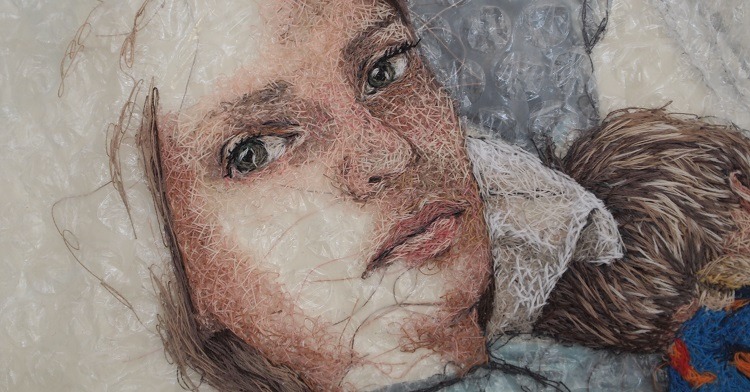
Comments